Youth leadership mission trips Poland equip teens with discipleship, bilingual ministry, and leadership skills while serving alongside Polish youth.
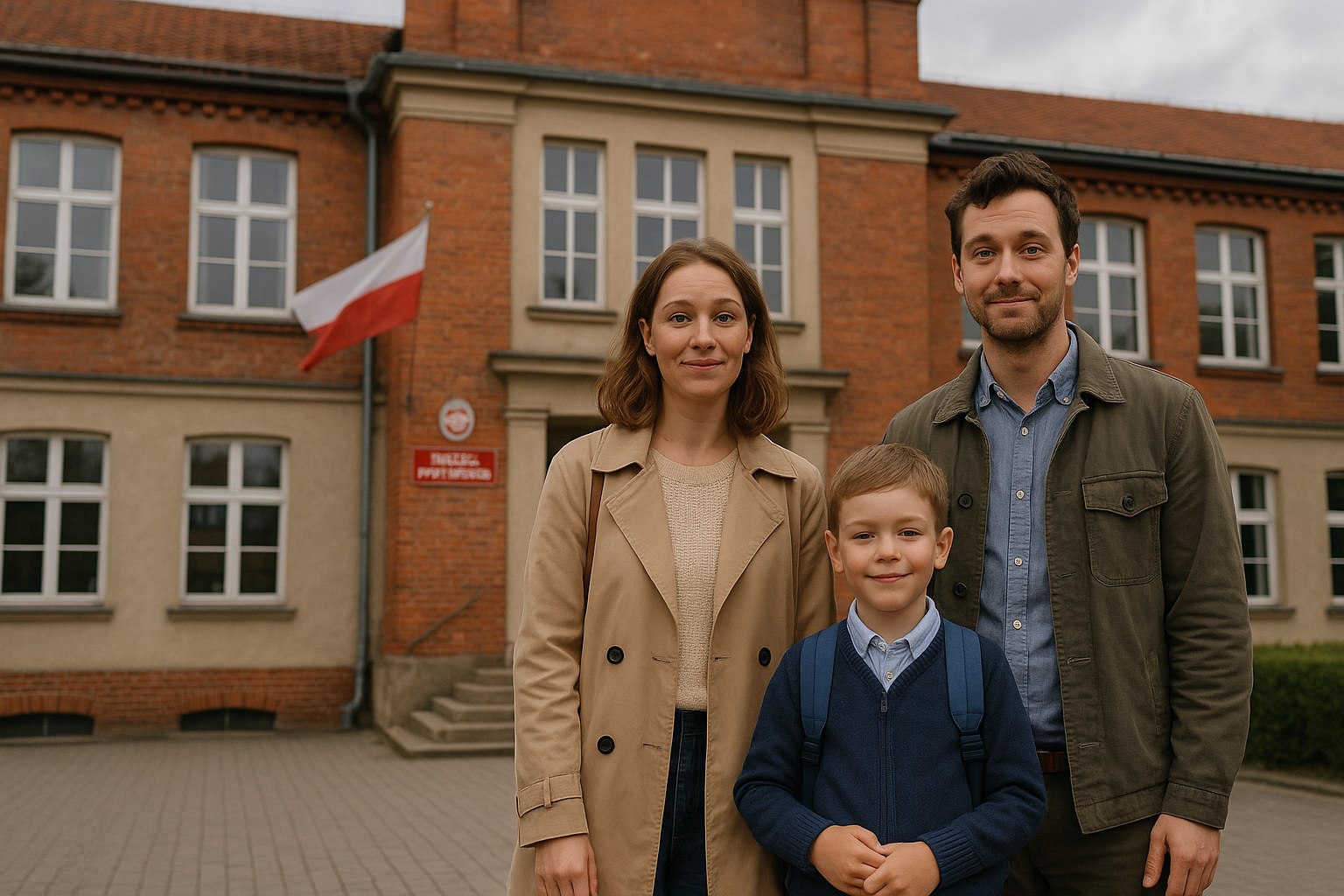

Enrolling children in Polish schools as a foreigner can feel overwhelming, but with the right information, the process is easier than you might think. This guide walks you through every step, from kindergarten to high school, and includes the laws, documents, and tips that every expat family should know.
Moving to Poland with kids brings one daunting question: how do you enroll your child in school in Poland without losing your mind? 🧠📄 School isn’t just a legal requirement here, it’s the key to your child’s new life. Get it right, and your son or daughter will be making friends and learning Polish swear words (just kidding, we hope) in no time 😅. Get it wrong, and you risk bureaucratic headaches, fines, or worst of all, a child who feels left behind 💔. This comprehensive guide was born because too many expat parents were piecing together outdated info from random forums. We audited everything out there, from city council pages to expat Facebook groups, and rolled it into one honest, no-panic guide ✅. So take a deep breath: we’re about to navigate the Polish education maze together, with a smile and zero fluff.
First, let’s acknowledge the stakes ⚖️. Poland requires schooling for all children from age 7 until 18. If you’re thinking, “What if I skip it for a while until we settle in?”, imagine Polish officials clucking their tongues 👮♂️. Long-term truancy can lead to warnings, fines up to 10,000 zł 💸, and even involvement of family courts in extreme cases. In short, ignoring school isn’t an option, and honestly, you wouldn’t want to. School is where your child will pick up the language, make local friends 👯♀️, and gain a sense of normalcy in a new country. It’s also where you, dear parent, will get a crash course in Polish bureaucracy (don’t worry, we’ll make it as painless as possible) 🧾😉.
Throughout this guide, we’ll tackle everything: understanding Poland’s school system, nailing the paperwork, navigating local zoning (“rejonizacja”) 📍, dealing with language barriers 🗣️, and knowing your rights 📚. We’ll keep the tone human and even sprinkle in some PG-rated humor 🤭, because if we can’t laugh at the thought of wrestling a copier for enrollment forms, what can we laugh at? By the end, you’ll have a final checklist ✅ to make sure you’ve dotted every i and crossed every ł (that’s a “W” sound in Polish, by the way). Let’s get started on enrolling your child in a Polish school, and banish that panic for good! 🚀
A foreign mom and dad stand proudly with their child in front of a Polish school, looking both nervous and excited for the first day. Enrolling your child in a new country’s school can feel scary, but it’s also the start of them finding their feet (and maybe doing the polka in a school recital) 💃.
🦘 Jump to…

Before diving into forms and offices, let’s demystify how Poland’s school system is structured. The good news is that it’s fairly straightforward (no Hogwarts-style sorting hat, we promise) 🎩. Education in Poland is compulsory from age 6 through 18.
One year of kindergarten (przedszkole) at age 6 is mandatory as preparation for school. This is often called “Zero grade” or zerówka – more on that in the next section. Then comes primary school (szkoła podstawowa), which lasts 8 years, covering grades 1 through 8 (usually ages 7 to 15) 📚. Primary school is split into two stages: a gentle introduction in grades 1–3 where one teacher handles most subjects, and a subject-based stage in grades 4–8 with different teachers for math, science, etc. 🧮🔬. At the end of 8th grade, kids take a final exam (egzamin ósmoklasisty) to see how much knowledge stuck – think of it as Poland’s way of keeping 15-year-olds humble 😅.
After primary, students move on to secondary education (szkoła średnia). There are a couple of paths here. The most common is the 4-year general high school (liceum ogólnokształcące) which ends with the matura exam (Poland’s version of SATs, but with more poetry and no multiple choice) ✍️📖. There’s also a 5-year technical high school (technikum) which combines regular academics with vocational training – it also ends in a matura and a professional diploma 🎓🔧. For teens more eager to work with their hands, Poland offers trade schools (branżowa szkoła) where after a 3-year first stage they get a vocational qualification, and they can optionally do 2 more years (second stage) to have a shot at the matura later. In any case, to go to university, your child will need to pass the matura at the end of secondary school. The Polish system is designed so that, by around age 19, students either dive into higher education or head into the workforce with a solid education under their belt 🎯.
If you’ve done homework on Poland, you might have heard of something called “gimnazjum” (middle school). Don’t let old info confuse you – Poland reformed its education structure a few years back. Until 2017, kids did 6 years of primary + 3 years of gimnazjum. That system was scrapped by a 2016 law, returning to the classic 8-year primary model 🧾. So everything is now in one continuous primary school from grades 1 to 8. Why mention this? Because you might still find references to gimnazjum in older guides (and possibly in the dusty corners of some school buildings) 🕰️🏫. Just know that as of 2025, gimnazjums are history – literally. All primary schools now go up to 8th grade, and secondary schools have adjusted to 4- or 5-year programs accordingly ✅.
A typical Polish primary classroom with young students. Notice the national white-and-red flag and the coat of arms (the white eagle) watching from the wall – Poland takes its education (and symbols) seriously. From zerówka to Matura, the journey is long but well-mapped out in Poland’s school system 🦅🇵🇱.
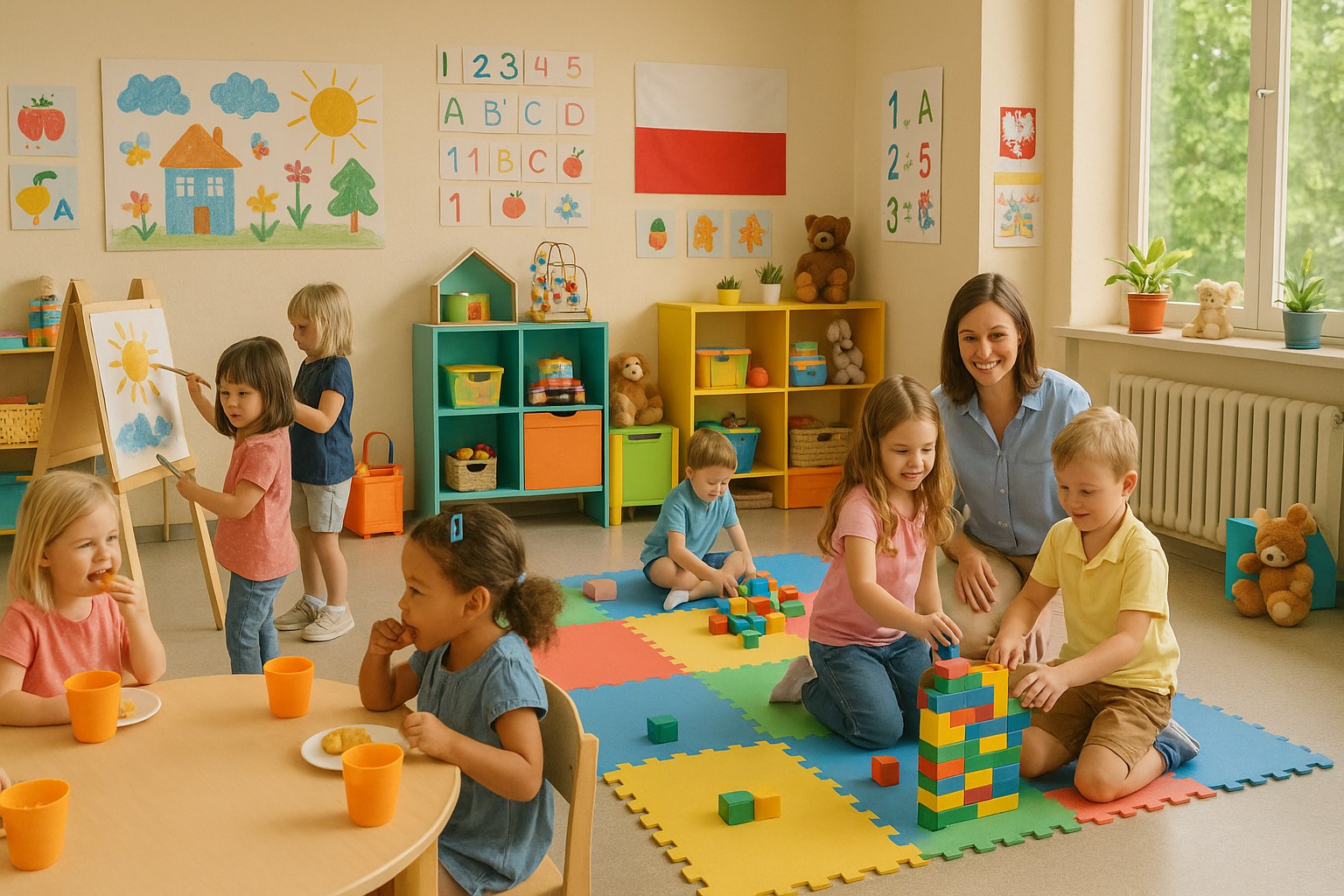
Kindergarten in Poland (przedszkole) is where children aged 3 to 5 get their first taste of group play, glue sticks, and maybe a few Polish lullabies 🎨🎶. For foreign parents, the first thing to know is that kindergarten isn’t mandatory for those ages – but it is very common. From age 3 up, kids have the right to a public preschool spot, and by age 5 the commune (gmina) must ensure a place if you want one. Most Polish kids attend at least one year of preschool before the compulsory year, and it’s a great way for foreign children to pick up language basics while finger-painting 🖐️🖌️.
The big deal is “Zero grade” (zerówka) – the preschool year for 6-year-olds that is compulsory by law 🏫📅. Essentially, the calendar year your child turns 6, they must be enrolled in an educational program to prepare for primary school. This can be done either in a standalone kindergarten (many preschools have a zerówka class) or in an “0” class attached to a primary school. It’s a preparatory year focusing on basics like learning to hold a pencil properly ✏️, recognizing letters and numbers 🔢, social skills, and perhaps how to politely ask to go to the toilet in Polish 🚻. By the end, the teacher issues a school-readiness certificate (you’ll need that when registering for 1st grade).
Now, some flexibility: If your child is academically or developmentally ready, you can request they start 1st grade early at age 6 (skipping zerówka) – this requires a psychological assessment stating the child is up for it 🧠. Conversely, if your 7-year-old isn’t quite ready for prime time (maybe they didn’t attend preschool and you feel they need that prep year), you can apply to defer the start of primary by one year. This also involves getting an opinion from a psychological-pedagogical center. Polish law allows this so that no child is shoved into first grade before they’re ready to succeed ✔️.
Enrolling in kindergarten is a process that happens earlier in the year than primary school enrollment 🗓️. Typically, each city or gmina runs a recruitment in late winter or early spring (February–April) for admission the following September. You usually fill out an online form (for example, Warsaw has an electronic platform) or a paper application listing your top choices (usually up to 3 preschools ranked by preference). Priority criteria often apply: for instance, kids with disabilities ♿, from large families 👨👩👧👦, in foster care 🏠, or with single parents 👩👧 get extra points. Don’t be discouraged if you’re not in any special category; many expat families still get a spot, though maybe not in the nearest or most popular preschool.
If you arrive in Poland mid-year or after the main recruitment, you can still enroll your child in a preschool or zerówka if there are places. In this case, you’ll apply directly to the school or through the local education department 🏢. By law, 6-year-olds must be accommodated even outside the standard enrollment period. The key is to contact your gmina’s education office – they’re responsible for finding a spot for any child who needs one. And remember, at this age the focus is on play and socialization 🧸🤹♂️. For foreign kids, kindergarten is a gentle (and often fun) immersion into Polish language and culture – think songs, snacks, and afternoon naps 🥨🛏️, not strict academics.
Three- to six-year-olds blending into Polish kindergarten life: painting, building block towers, and chattering away (in Polish gibberish that will soon become real Polish). Kindergarten – especially the compulsory zerówka at age 6 – gives foreign kids a soft landing before the real school adventures begin 🚀.
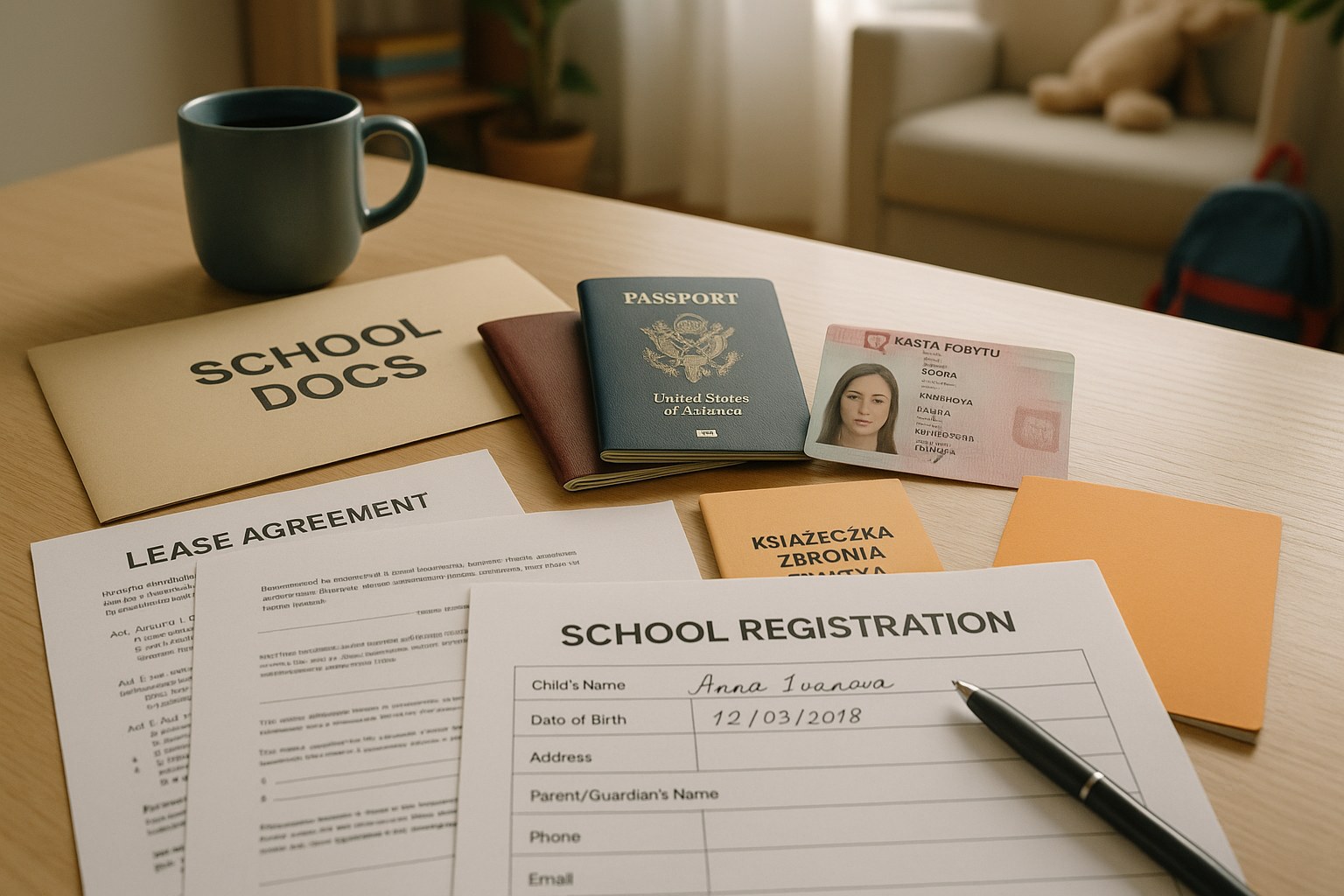
Enrolling a child in a Polish school involves paperwork – it’s unavoidable, but not insurmountable. Let’s break down the documents and legal must-haves so you can arm yourself with a mighty folder of paperwork 📁✍️ (and avoid repeat trips because you forgot that one pesky copy).
Application Form: Every school (and kindergarten) has a registration form, usually available from the school office or online. For primary schools, if you’re enrolling for first grade in the standard spring recruitment, there may be a city-wide online system. Otherwise, you’ll fill out a paper form at the school. This form will ask for basic data: child’s name, PESEL (Polish national ID number) or birthdate if no PESEL, parents’ info, address, etc. Don’t worry if your Polish is shaky – you can often find someone at the school who speaks English or bring along a Polish-speaking friend to help translate the form. The form typically includes a statement where you, the parent, affirm that all info is true under penalty of, well, some frightening-sounding law 🖋️. Just standard stuff.
Child’s Identification: You will need to prove your child’s identity and age. A passport is ideal for foreign kids. If your child doesn’t have a passport yet (or it’s being processed), a birth certificate might be accepted, but if it’s not in Polish you should bring a translated copy just in case. Some schools might make a copy of the ID document for their records.
Parent/Guardian ID: Bring your passport or residence card. Schools want to verify that the adult enrolling the child is indeed their parent or legal guardian. If you have a Polish ID (dowód osobisty) or a residence permit card, that works too. Again, a copy may be taken 🪪.
Proof of Address: This is where that word “meldunek” pops up, which we’ll discuss fully in the next section 🏠. Many schools will ask for proof that you live in their catchment area (if you’re enrolling in your district school). The gold standard is a zameldowanie certificate (official registration of address), but a lease agreement or utility bill in a parent’s name can often suffice. If neither is available (e.g. you’re subletting without a lease, or your landlord refuses to register you), don’t panic – by law, lack of official address registration cannot bar a child from school. You might need to sign a statement of where you live. Some principals might raise an eyebrow if you lack meldunek, but they can’t deny your child an education over it. More on tackling this in the Zoning section.
Previous School Records: If your child has attended school elsewhere (even kindergarten or partial grades), bring any records you have: report cards, transcripts, certificates of completion 📄. For first grade, if the child completed zerówka in Poland, you’ll need the certificate from the preschool. If you’re coming from abroad and your child has already done a year or two of primary, a transcript or a letter from the old school (even in English) will help the new school know what grade to place them in. No records at all? Polish regulations allow schools to admit a child based on the parents’ written declaration of what grade the child completed abroad. In other words, if you fled an alien invasion 👽 and all papers burned up, you can still enroll – you’ll just state “Johnny finished Grade 3 in X country” and sign it. They trust but also kinda warn you not to lie (falsifying documents is a criminal offense, etc.).
Health and Vaccination Records: Surprisingly, Polish schools do not typically require proof of vaccinations or a medical exam to enroll 💉. There is no equivalent of the “no shots, no school” rule here – though vaccinations for kids are legally required in Poland, enforcement is separate from school admissions. Some preschools might ask for a doctor’s note that the child is fit for group attendance (mostly to ensure no communicable diseases at the time of entry). If your child has any health conditions (allergies, asthma, etc.), you should inform the school nurse or administration, but there’s no formal health form during enrollment in most cases. It’s more of an as-needed disclosure 🩺.
Legal Residence of Parents: Here’s a pleasant surprise: your own immigration status does not affect your child’s right to attend school 😊📘. Polish law explicitly guarantees education for every child residing in Poland, regardless of citizenship or residence status. Schools should not be asking for your visa or residence card when enrolling your kid (and if they do out of curiosity, it’s not grounds to refuse enrollment). So even if you’re in the middle of sorting out your visa or are on a tourist stamp, your child can and should be in school. That said, if you have a PESEL number or any Polish documents, providing them can make life easier – some school databases like to have ID numbers. But again, they cannot turn your child away for not having a PESEL or Polish citizenship. Many foreign parents breathe a sigh of relief on hearing this 🧘.
Lastly, once your child is accepted, the school may ask for some additional items for their file: a passport-sized photo for the school ID (more on the awesome uses of the school ID later) 📸, perhaps a photocopy of their immunization book (so the school nurse knows who needs what), and various signed consents (for things like your kid going on local field trips 🚌, or being in school photos). These aren’t needed at the initial enrollment stage but will come up on the first days of school. To summarize, as long as you have ID for you and your child, proof of address, and any prior school docs you can gather, you’ll be in good shape to enroll. Poland’s official stance is clear: no child should be left without education due to missing documents or foreign status. Knowing this is half the battle – and for the other half, there’s the next section on addressing that pesky address issue 🧠💪.
Gather your paperwork arsenal: passport, birth certificate, lease contract, previous school records – and don’t forget a good pen 🖊️☕. Enrolling in a Polish school involves a few forms and signatures, but armed with the right documents (and maybe a coffee), you’ll conquer the paper mountain in no time 🏔️.
If you’re still in the process of getting your legal stay sorted — like PESEL, bank account, or residence permit — we can help. Our Relocation Services cover all the legal admin needed before your child can be fully enrolled.
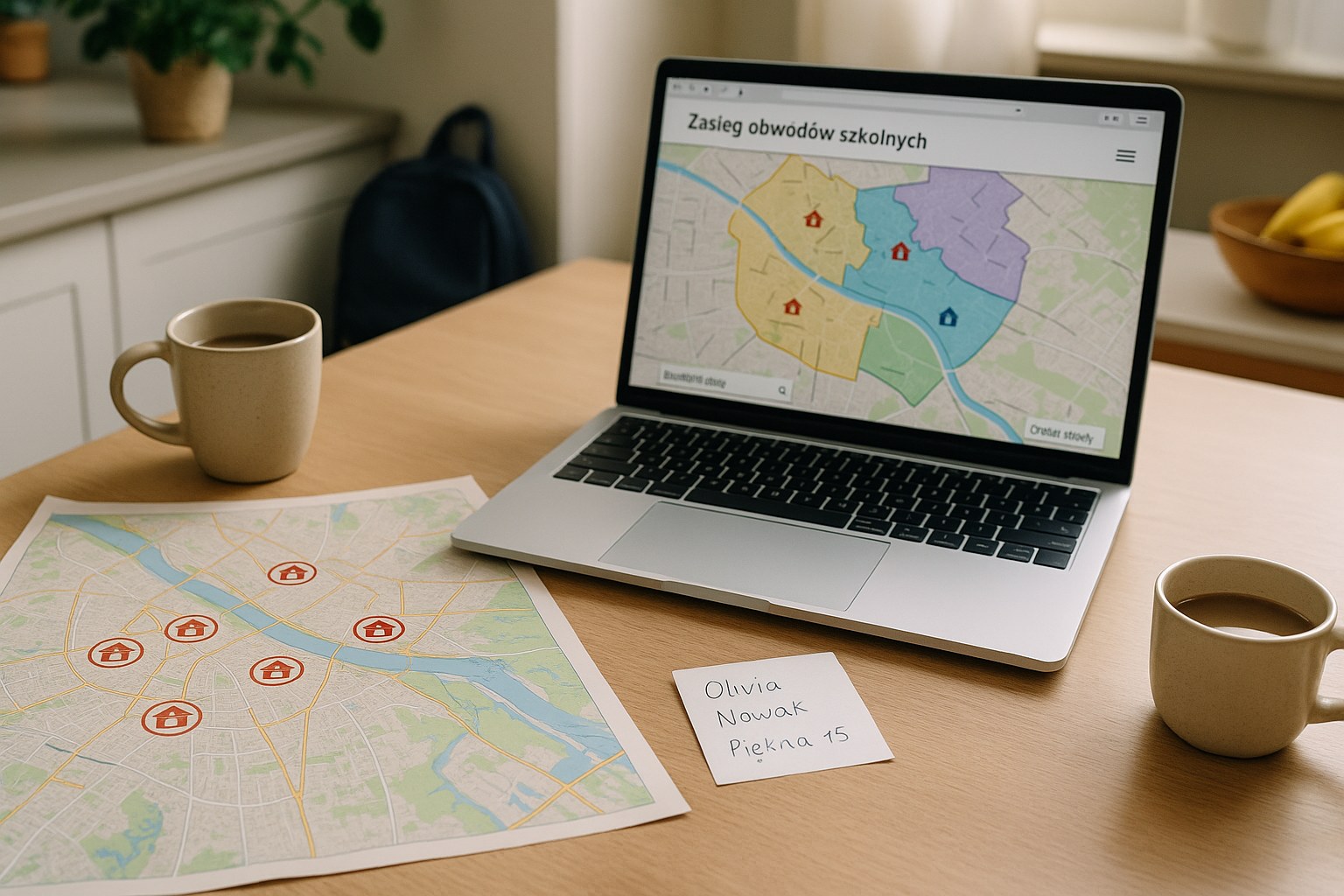
Now let’s talk about school zoning (rejonizacja) – a concept that might be new if you come from a country without strict catchment areas. In Poland, every public primary school has a designated catchment area, usually a defined list of streets or an area on the map 🗺️. If you reside in that area, that school is obliged to accept your child for grades 1–8, guaranteed. Think of it as your “neighborhood school.” This is great because it means no primary-aged child will be without a school seat; one is reserved by default wherever you live:contentReference[oaicite:23]{index=23}. However, it also means you can’t necessarily choose any school in the city and waltz in – priority goes to locals in the zone.
The practical upshot: if you’re enrolling your child in 1st grade (or any grade) at your local assigned school, you generally just submit the application and you’re in ✅. If you want a different public school outside your zone (maybe it has a special program or just a great reputation ⭐), you can apply, but you’ll be an out-of-district candidate. Those are only admitted if the school has free places after all its zoned kids are enrolled. Popular schools in big cities often fill up with just local kids, but it’s always worth a shot if you have a strong preference. Some schools do lotteries or point systems for out-of-zone applicants when demand exceeds spots 🎰. Remember, though: your child is always guaranteed a place somewhere – if not in the preferred school, then in your district school or another one the city assigns.
Meldunek (official address registration) is a word that strikes both fear and confusion in expats 😰. By Polish law, anyone living in Poland longer than 30 days should register their address with the local authorities. In practice, many foreigners struggle with this because it requires either owning a property or getting your landlord’s sign-off 🏘️. However, for school enrollment, what matters is proving you actually live at a certain address (not necessarily that you have a piece of paper saying so). If you have your zameldowanie certificate, fantastic – it’s the easiest proof of address. But if you don’t, schools will usually accept a rental agreement or a utility bill in the parent’s name listing that address. Some online enrollment systems even cross-check the PESEL address database – which won’t help if you’re not registered, but then they’ll ask for alternate proof.
What if your landlord outright refuses to sign a meldunek form or you’re subletting and have no official lease? Don’t panic or let it stop you 🚫. Legally, a child has the right to attend the school in whose area they reside – “reside” being the keyword, not “are officially registered.” If you can’t supply a standard document, you can write a declaration of your address and circumstances ✍️. The school or gmina might do an extra check (in rare cases they can even send someone to verify the family lives there – but that’s unusual). Worst-case scenario, if a local school tried to reject your child over the address technicality, you should contact the Education Department of your Gmina 🏛️. They have a duty to place your child in a school and will sort it out (likely by reminding the school of the law). In Warsaw, for instance, the city explicitly states that a child must be admitted to the district school regardless of their legal status or lack of PESEL:contentReference[oaicite:24]{index=24} – this includes not having meldunek.
To find out your assigned primary school, many city websites offer handy tools 🖥️. For example, Warsaw has an online boundary map where you can input your address to see your school (Warsaw school finder):contentReference[oaicite:25]{index=25}. Kraków’s recruitment portal provides a list of schools by street as well:contentReference[oaicite:26]{index=26}. If you’re unsure, call your local city education office or ask neighbors – someone will point, “Yes, that school on Nowa Street is for our block.” For secondary schools, zoning doesn’t apply – admission is citywide by competition (more on that later). But for primary, zoning and address are king 👑.
A quick note on addresses: If you move during the school year to a new district, you can transfer your child to the new local school (they must take them mid-year since now you reside in their area), or you can keep them in the old school for consistency – your choice 🔁. Just inform both schools and handle the paperwork of transfer. And if you’re brand new in town with no permanent address yet (like living in temporary housing or with friends), enroll using the address where you and the child are actually staying. You can always update it later. No school is going to send a kid away because the family is in between apartments – again, they might ask for a clarification, but they must provide education.
In summary, don’t let the lack of a stamped form scare you away from enrolling your child. Use whatever proofs you have to show where you live 📄. Understanding the system – that every address is tied to a school, and every child has a school by default – helps you assert your child’s right. And if anyone tries to give you the runaround about meldunek, you now know to smile politely and remind them that little Jan or Aisha has a constitutional right to that desk in class, no matter what the paperwork says 🎓.
Homework for parents: figuring out which school district you’re in. A laptop and a map of the city with school icons pinned will save you a world of confusion 🧭. Whether or not you have a “meldunek” stamp, your address on that map ties you to a local school – and that school has a desk with your kid’s name on it 🪑.
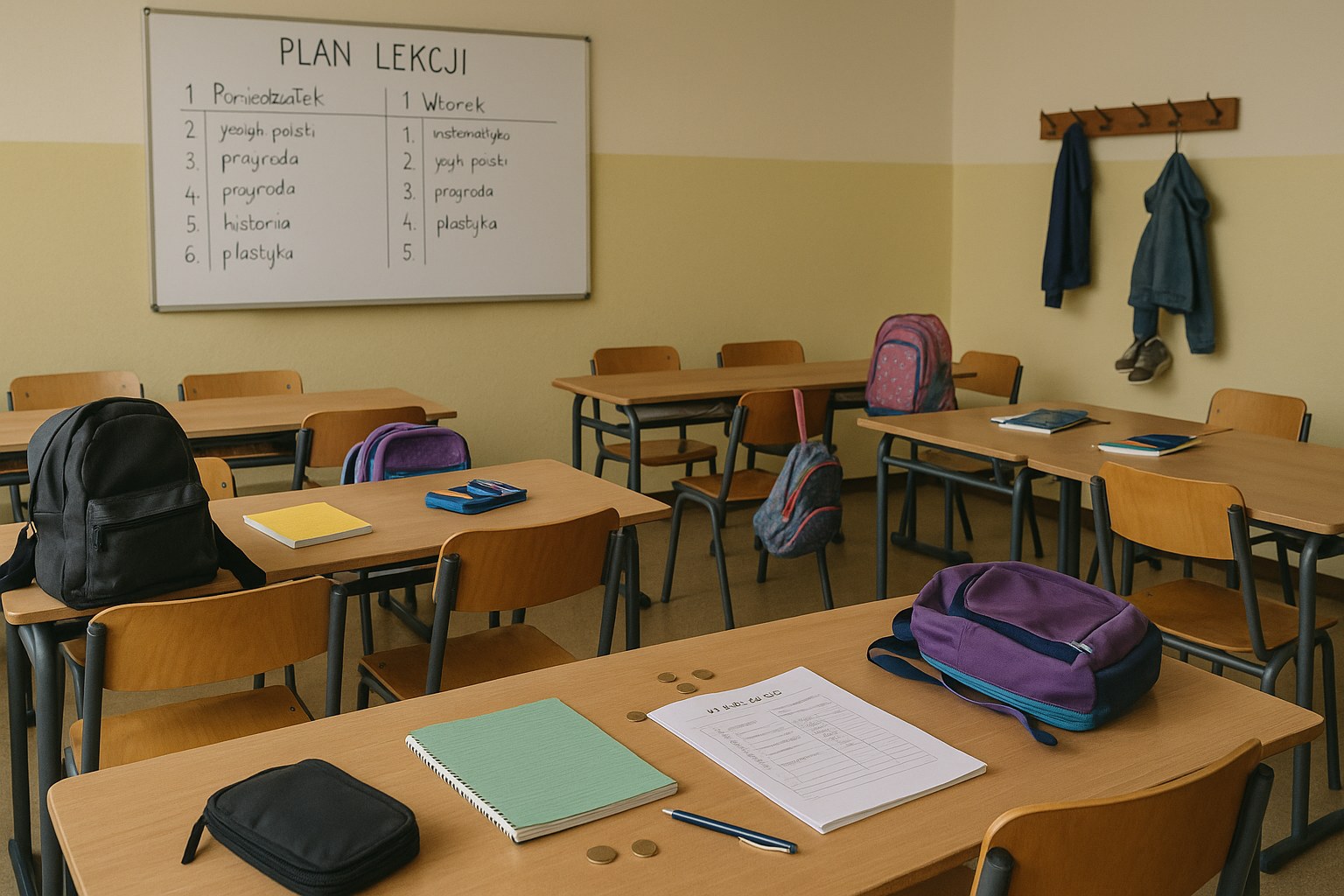
Time for the money talk 💬. One of the best things about Polish public education is that it’s free of charge to attend 🎓. This applies equally to Polish citizens and foreign kids – up until age 18 (or graduation from high school) you won’t pay tuition in public primary and secondary schools. No monthly fees, no “donations” required to walk in the door. That said, “free” doesn’t mean you won’t spend anything. There are plenty of ancillary costs that can surprise you if you’re not prepared. Let’s break down what’s free and what isn’t in 2025 💡.
What about private schools? If you choose a private or international school, none of this applies. You’ll pay tuition, which can range from several thousand zł/year at smaller Polish private schools to over 50,000 zł for elite international schools 💼. Everything we’ve mentioned here about “free” only applies to the public system.
To sum up the finances: you won’t pay a cent to enroll or attend public school, but be ready for realistic extra costs like food, field trips, and supplies 🧾. A foreign child has the same entitlement to free education as a Polish child, so use the savings to buy a great backpack and maybe a solid Polish-English dictionary. And when you get that surprise message from the teacher asking for three packs of printer paper or plastic cups, just smile 😅. At least you’re not paying tuition. Poland’s public schools truly do their best to make education accessible without putting you in debt.
Public school in Poland won’t drain your bank account with tuition – but you’ll still find yourself buying loads of notebooks, packing lunches, and chipping in for the occasional class pizza party 🍕. Here a parent double-checks their wallet, ready to fund the next school trip or that fancy pencil case their child just had to have ✏️.
Many families relocating to Poland are surprised by what’s free and what’s not. If you’re still budgeting for your move, our Relocation Services page includes transparent pricing for housing, banking, health insurance, and more.
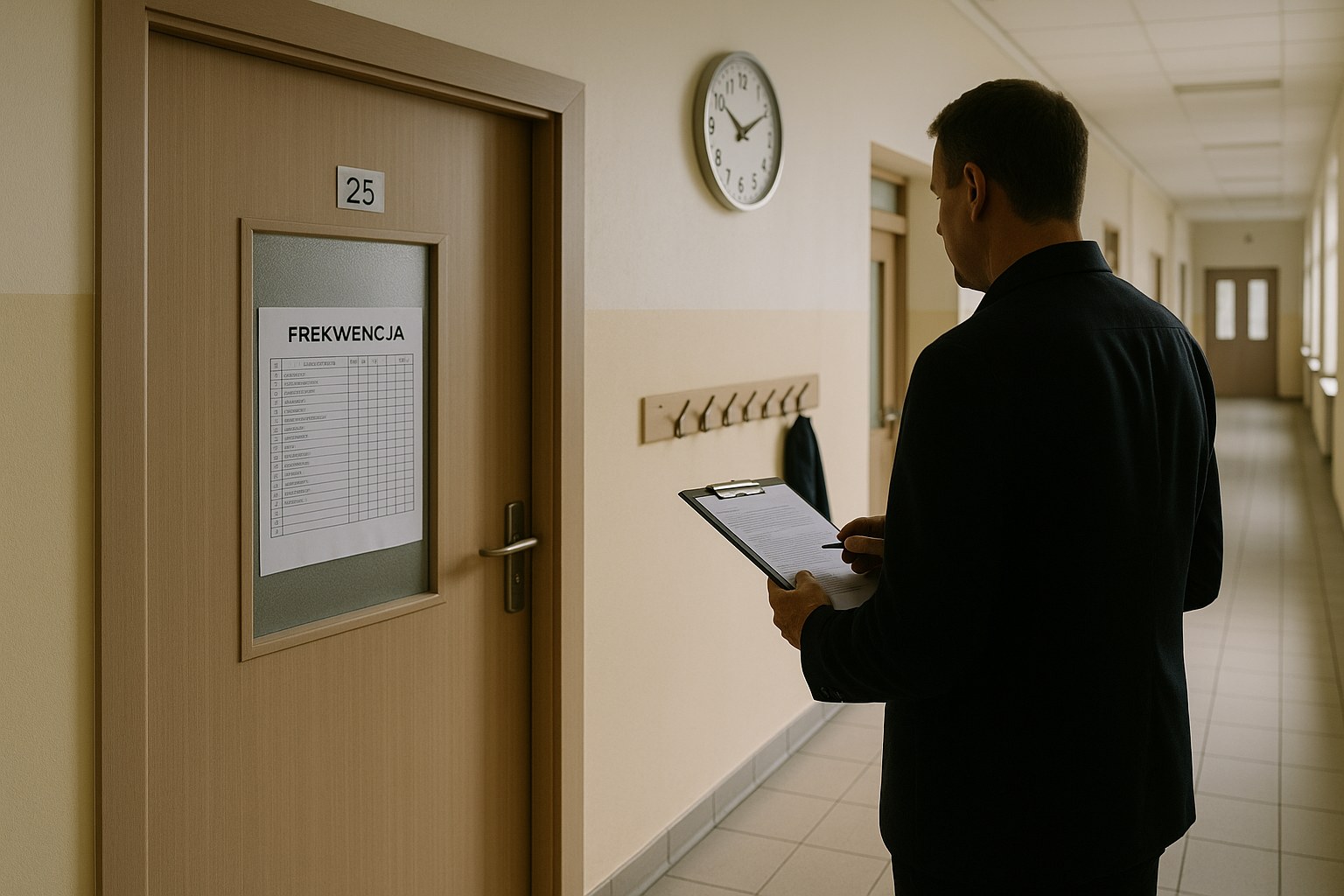
Poland doesn’t mess around when it comes to making sure kids go to school. The rules on compulsory education are crystal clear and important for every parent (local or foreign) to understand. In plain terms: education is obligatory from the year a child turns 7 until they turn 18.
This obligation actually has two parts in Polish law:
For foreign parents, the key takeaway is that these rules apply to all children residing in Poland, regardless of nationality or visa status. If your family is living here, you are expected to ensure your kids are in school. There’s no “we’re expats, different rules” clause – nope. 🛑
Now, what if someone doesn’t follow the rules? Let’s say a child is not enrolled, or they’re enrolled but not showing up. Polish schools have attendance tracking and they take action when there are excessive unexplained absences. Typically, if a student misses over 50% of classes in a month without valid excuse, the school will flag it. 🚩
The first step is usually a warning letter from the school director or local education authority to the parents. It’s kind of a “hello, we noticed your child isn’t in school – please fix this” notice (in polite bureaucratic language).
If the situation doesn’t improve, the matter can be referred to the municipal authorities (specifically, the gmina office responsible for education) and eventually can trigger an administrative enforcement procedure. Under the Act of 17 June 1966 on Enforcement Proceedings in Administration – yes, a law from 1966 is still the basis for this – the authorities can impose a fine on parents for failing to ensure the child’s attendance. 💸
The maximum fine at one time is 10,000 zł, which is roughly €2,200 or $2,500. In practice, fines are usually smaller and often they’ll start with a warning or a token fine to get your attention. But they can repeat the fine (after further warnings) if truancy continues, up to a total cap of 50,000 zł. So, persistent school-skipping could theoretically cost an arm and a leg. 🧾
Beyond fines, in truly severe cases of educational neglect, the school or authorities might refer the case to the family court. If a judge believes a parent is willfully not sending a child to school and thus harming the child’s welfare, they could take measures like monitoring the family through a court guardian, or in worst-case scenarios, limit or remove parental rights. That’s an extreme that typically would require additional issues (e.g., general neglect, not just homeschooling or something). But it’s on the books. ⚖️
📣 Special note for those under temporary protection (like many Ukrainian refugee families in Poland): The Polish government in 2023–2024 cracked down on ensuring refugee kids also attend Polish schools, rather than only doing online classes from abroad. They even tied some benefits to it. For instance, Ukrainian families who didn’t send kids to school risked losing their 500+ (now 800+) monthly child benefit and the one-time 300+ school starter grant. The idea is to incentivize attendance – basically a carrot-and-stick approach. 🥕📉
So if you’re an expat eligible for Polish family benefits, be aware those can be yanked if your child isn’t fulfilling school duties (though for most expats, it’s straightforward: your kid will be in school anyway).
Alright, deep breath – that was the scary part. 😅 Now for the reassurance: If your child is sick or needs to miss school for a valid reason, you won’t be hauled off in handcuffs. The law is about unexcused, prolonged absences and outright non-enrollment. Polish schools will work with you if, say, your child has health issues or other legitimate circumstances – usually via an individual education plan or temporary homeschooling arrangement. The key is communication and having it officially recognized. 📝
The bottom line: Poland treats education as a right of the child and a responsibility of the parent. And they enforce it. As a foreign parent, so long as you enroll your child and ensure they attend regularly, you’ll never have to worry about these penalties. It’s really aimed at those who ignore repeated reminders. ✅
In short: get them in school, communicate with the teachers, and truancy fines will remain something you only know about from the internet (and hopefully not from a letter in your mailbox!). 💌
The truancy watchdogs: Polish school principals and local authorities are tasked with enforcing compulsory education. Picture a principal tapping their watch in an empty hallway – if your child is consistently MIA without a good reason, expect a formal nudge (and eventually a fine) to get them back in class. It’s Poland’s way of saying “education first, folks.” 🎯
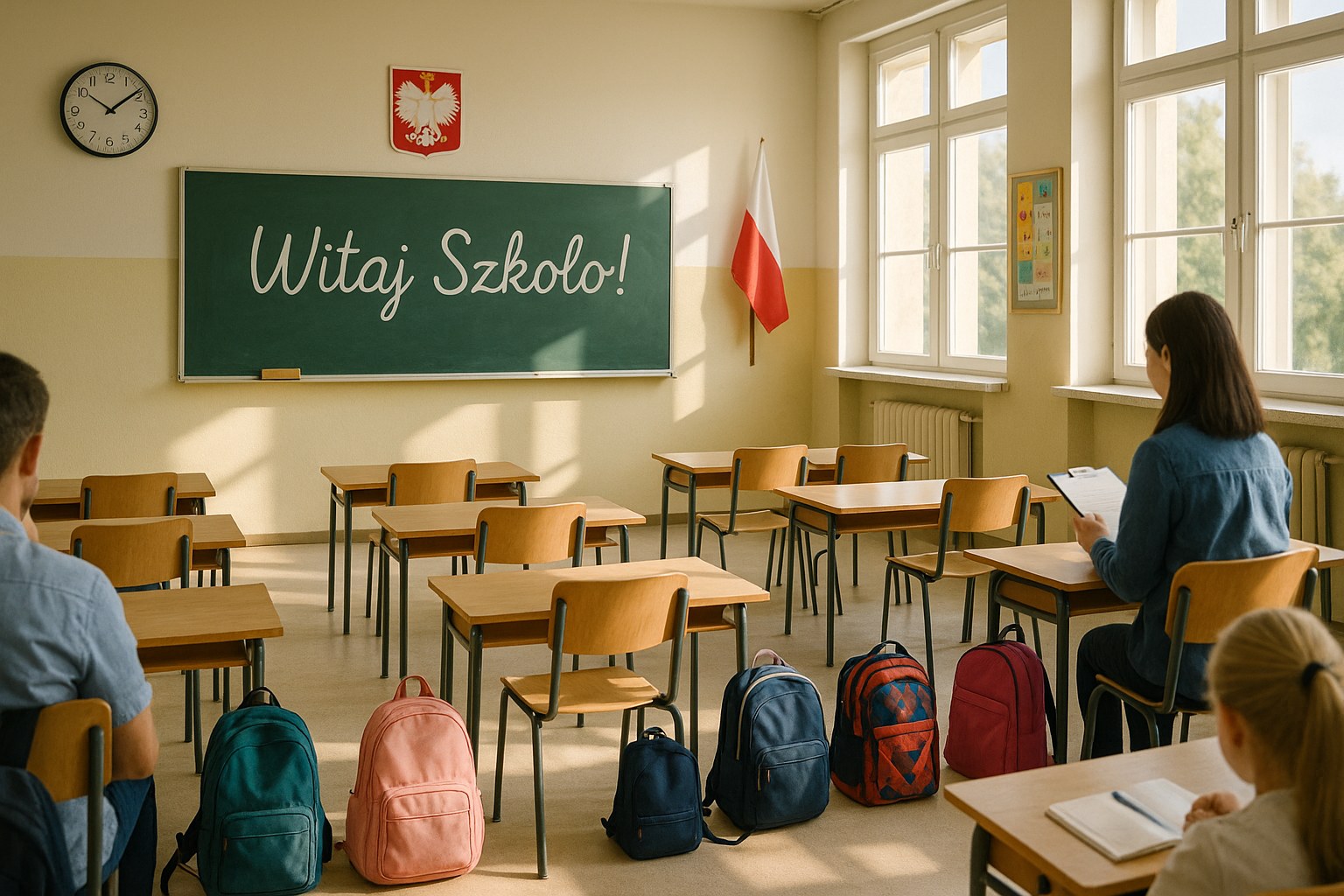
Mark your calendars, parents – the Polish school year has its own rhythm that you’ll want to get familiar with. Let’s start with the big picture: when school starts and ends. The academic year in Poland traditionally begins on September 1st each year (if September 1 is a weekend, they’ll start on the next Monday). In 2025, for example, the first day of school is Monday, September 1, 2025. The year runs until the end of June; the last day of school before summer vacation is usually the last Friday of June. That’s when kids dress up, get their year-end report cards (świadectwo), and then promptly forget everything they learned as summer break begins. 🎓
The school year is divided into two semesters. The first semester runs from September until around mid-January. There isn’t a single nationwide “semester break” aside from the Christmas holidays, but the first term typically ends with a round of parent-teacher meetings and maybe a mid-year report. The second semester runs from February (after the winter break) to June. Schools will have a final round of grading and exams in late May or early June.
Schools may also declare bridging days or director’s days for long weekends – watch for these on school calendars.
Classes typically start at 8:00 or 8:30 AM, sometimes earlier. Each lesson lasts 45 minutes. After each lesson, students get a 5–10 minute break, with one longer mid-morning break (~15 minutes) for their “second breakfast” 🥪.
Grade 1–3 students usually finish around 12:00–13:30. After that, many stay in świetlica (after-school room) until 17:00–18:00. It’s supervised, free, and a lifesaver for working parents.
Grade 4–8 students may have 6–7 lessons and finish closer to 14:00–15:00. High schoolers may have up to 8 periods, ending near 15:30. Some schools rotate or shift timetables to manage building usage.
Lunch is flexible – students who buy meals eat during a scheduled break (typically after 4th period). Others just use that time for a snack.
Many schools offer free extracurricular clubs like art, sports, or music. Municipal youth centers also run affordable programs.
These usually happen twice per year, once per semester, often in late afternoons. Expect to hear how your child’s doing – and maybe hear a few surprises.
📌 Pro tip: Keep a calendar on your fridge. Between school events, holidays, costume days, and long weekends, your future self will thank you.
🛎️ The Polish school year at a glance: First bell rings in early September, final bell in late June, with plenty of pit stops (Christmas, winter break, spring break) in between. And yes, those scribbles are 45-minute lesson slots – your child will soon be a master of the “quick 10-minute recess snack and play” routine.
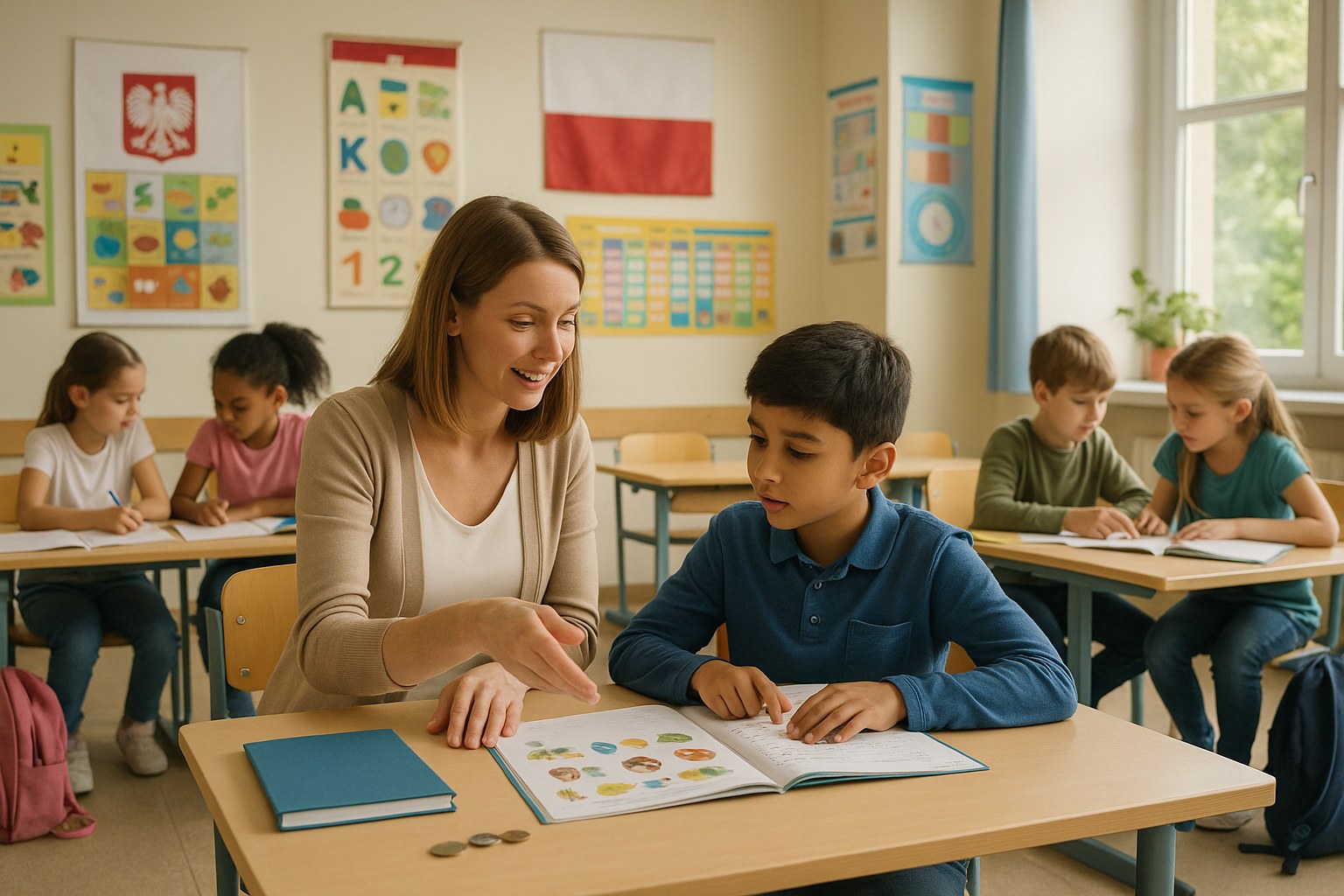
Entering a Polish school as a foreign kid can feel like landing on another planet 🌍 – new language, new customs, maybe everyone is obsessed with a sheep named Matołek (you’ll learn). The good news? By 2025, Polish schools have plenty of experience integrating non-Polish speaking students, and there are systems in place to help your child feel less lost in translation. Here’s what to expect – and how to tap into that support. 👇
By law, every foreign student is entitled to free Polish language lessons alongside their regular classes. Usually, your school will schedule two or more Polish as a Second Language classes each week 🗓️ – often during school hours. Some students might have one-on-one lessons, others may join small groups. These classes cover everyday words, classroom basics, and grammar 🧠. It won’t make your child fluent overnight, but it builds real progress. Some schools even offer more hours – especially in cities that welcomed Ukrainian children in large numbers.
In cities or towns with many non-Polish speaking children, your school may offer a “prep class”. These are transition classes focused heavily on Polish and gently paced learning. Think of them as a soft landing zone 🚀 – your child will join a regular class once they’re ready. Not every area has them, but they’re worth asking about, especially in big cities like Warsaw or Kraków.
Some schools hire bilingual assistants to help foreign kids – especially where several children share the same language. It’s common in schools with Ukrainian students, where a Ukrainian-speaking aide might sit in class to help translate and guide. If your child is the only speaker of their language, this is less likely, but if a few of you ask together, the school might consider it 🤝.
Will your kid be graded the same as Polish kids from day one? Not always. Especially in early grades (1–3), teachers use more flexible, qualitative evaluation. 🧾 In older grades, teachers often cut foreign kids some slack – offering simpler assignments, allowing dictionaries, or skipping certain tests. While the grading scale is the same technically, teachers often adjust expectations to avoid discouragement. Ask about individual learning plans and realistic goals for your child’s pace 📈.
If your child is behind in certain subjects – like math or science – they can receive extra help sessions. These are called compensatory or remedial classes, and schools receive extra funding for them. Total support (Polish + others) is capped at five lessons a week to avoid overload 😅. Don’t hesitate to ask the school to arrange targeted help for specific gaps.
Many teachers create informal buddy systems. Your child might be paired with a friendly Polish classmate who speaks some English (or another shared language) to help guide them 🧍♂️🧍♀️. Older students sometimes even volunteer to tutor younger foreign pupils. This kind of social connection builds confidence and friendships quickly. Kids love helping other kids.
Many schools organize cultural days, food festivals, or welcome events to include foreign students and teach diversity. Encourage your child to share their culture – whether it’s food, music, or a dance – and it may become their proud moment. 🍱🕺
All Polish public schools have access to a psychologist or pedagogue. They help with emotional and social support. If your child feels isolated or overwhelmed, talk to the homeroom teacher about arranging a session. These professionals can also advise teachers on how to include your child better. Most work in Polish, but they’re used to non-Polish speakers – some even speak English or use translation tools. 🧠💬
Community centers and local NGOs often offer free Polish lessons, tutoring, or weekend integration events. In larger cities, you’ll find expat-specific programs or even Saturday schools. 💡Connect with other parents (via Facebook groups or at school) – they often know great tutors, assistants, or what’s worked for their kids.
Integration isn’t just possible – it’s expected. Polish schools today understand that foreign children need support to thrive. There are laws to protect that, and teachers are generally open to helping. The earlier you start communicating with the school, the smoother the transition. 💬👨🏫 Celebrate progress – one joke understood, one “A” earned, one friend made – they add up fast. Before you know it, your child might be correcting your Polish. 😉
Newcomers often need more than language support — they need help navigating the whole system. We work with families every week who’ve just arrived. See our Relocation Services to get ahead of the admin so your child can focus on fitting in.

Don’t be surprised if one of the first questions on the school enrollment form is: “Will your child attend religious instruction?” Welcome to Poland, where religion (mostly Catholic) has a reserved spot on the weekly schedule – but attending it is entirely optional.[64] Here’s how it works and what you should know to make an informed choice for your family.
📘 The default scenario: In public schools, typically starting from grade 1, there are 2 class periods per week set aside for religion. In practice, this almost always means Roman Catholic catechism, taught by a catechist (who might be a nun, a priest, or a lay teacher appointed by the local diocese). The classes cover Bible stories, prayers, and Catholic teachings appropriate to the kids’ age. It’s not hardcore doctrine at the younger levels – more like “God loves you” and colouring pictures of Noah’s ark – but by later grades they delve into more specific church teachings.
⚖️ The alternative: If you opt out of religion, Polish law entitles your child to Ethics classes instead, if the school can organize them.[65] Ethics is a secular class about morals, philosophy, and civic values. It’s supposed to be available for those who don’t attend religion. However, here’s the catch: if only a handful of students in the school opt for Ethics, the school might claim they can’t find a teacher or there aren’t enough students to form a class. By law, even one student requesting Ethics means the school should provide it, but in practice compliance varies. Larger schools in cities increasingly do offer Ethics as an option because of more diverse student populations. If your school doesn’t plan an Ethics class due to low demand, you have a right to insist – but be prepared for potential scheduling awkwardness.
😌 If neither Religion nor Ethics: You actually have a third option, which is to have your child attend neither class. In that case, they just have a free period while others are in Religion/Ethics. In primary school, the kids who don’t go often are supervised by the library or in a study hall. Sometimes they just come to school later or leave earlier on those days if the schedule allows (with parental permission).
❓ So what should you choose? That depends on your family’s beliefs and what you’re comfortable with. Some considerations:
✍️ You should explicitly inform the school of your choice. Usually on the enrollment form or in the first week, you’ll sign a statement like “I request/do not request religious instruction for my child.” If you choose no, and want Ethics, specify that too (“I request ethics classes”). If later you change your mind, you can – but generally they want you to stick to one decision per semester.
📄 No grading pressure: Religion/Ethics are graded like other subjects, but those grades do not affect promotions or class ranking. They appear on the report card, but if a child doesn’t attend either, the report will just have a blank or “\/” in that spot. There is absolutely no penalty for not taking the class in terms of academic advancement. Schools might ask non-attending students to do self-study or something, but that’s more a formality.
🕌 Other religions: Legally, schools should also arrange instruction for minority religions if enough students request it (typically in cooperation with those religious communities). For example, Orthodox Christian, Protestant, Islam, Judaism – in areas with those communities, sometimes a priest or imam might come weekly to teach those children. But the numbers are usually small, so often those kids either join Ethics or skip. Some cities have inter-school ethics groups or religious classes (like all Muslim kids in a city might meet at one school). This is relatively rare though, unless you’re in a community with many co-religionists.
💬 Our advice for foreign families: Don’t feel pressured either way. If you’re atheist/agnostic or another faith, you can skip religion and talk to your child about why (good learning opportunity about respecting different beliefs). Polish law and increasingly school culture support your right to do so.[66] Your child might use the free period to catch up on homework – not a bad thing! If you do want an Ethics class but the school isn’t providing it, band together with any other like-minded parents and politely demand it – quoting the regulation that one student is enough to require a class. It sometimes takes a squeaky wheel to get that going.
🧠 It’s also worth noting: if your child does attend religion class and you’re not from a Catholic background, have a chat with them about it. They may hear things that are unfamiliar or not aligned with your beliefs. Many non-Catholic expat kids attend religion just to be with friends and treat it academically (“I’m learning about Catholic culture”). That’s okay if it’s okay with you. Some even find it interesting – Poland’s culture is steeped in Catholic tradition, so they pick up context. But if you foresee discomfort or confusion, Ethics might be the more straightforward path.
🛡️ Finally: know that whether a child takes Religion or Ethics or nothing, the school should not discriminate or treat them differently. In practice, little kids might ask “why aren’t you coming to religion?” – a simple “my family prays in a different way” or “I have a different class then” can suffice. Older kids usually couldn’t care less who goes where. And legally, the school can’t force anyone into religious practices. Even those in religion class can opt out of any specific religious activity if they want. Participation in religion lessons is voluntary,[67] full stop.
So: you have options. Choose what aligns with your family’s values, and remember – you’re not the only one navigating this. Poland’s public schools have been juggling religion vs ethics for decades. The key is that it’s your call, respected by law. Whether your child ends up learning the Hail Mary in Polish or discussing whether it’s okay to tell a white lie in Ethics, they’ll be just fine.
In many Polish classrooms you’ll spot a little crucifix on the wall – a nod to tradition. But don’t let appearances fool you: religion class is optional, and ethics (or simply sitting it out) is on the table too.[68] When it comes to faith in Polish schools, the choice is yours and your family’s – halo or no halo.
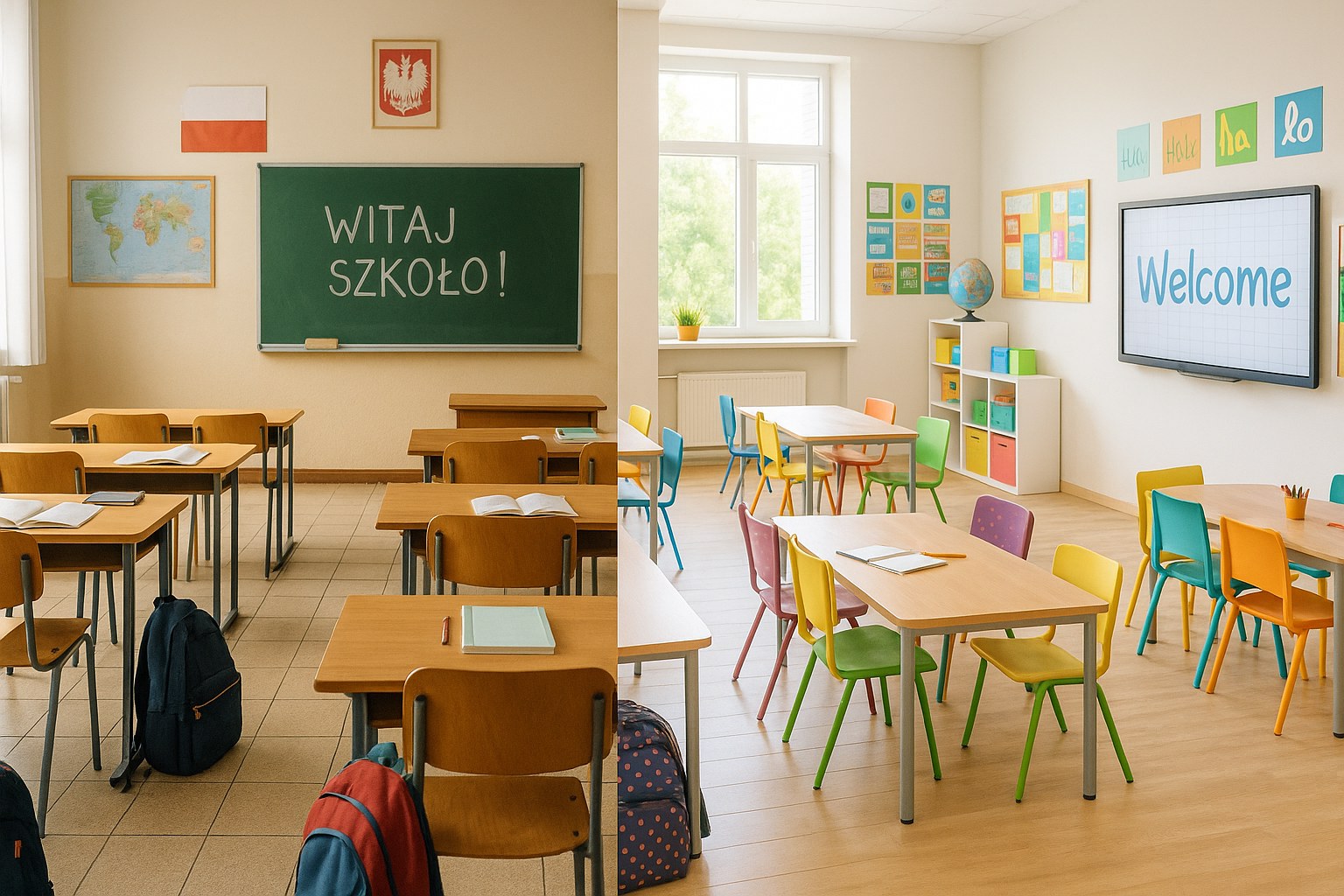
As a parent, you might be weighing the pros and cons of sending your child to a local public school versus a private (or international) school. 🇵🇱 Poland offers both, and each has its own flavor. Let’s dissect the differences so you can make the best choice for your situation.
💰 Cost and Admissions: The most obvious difference is cost. Public schools are free (aside from the minor expenses we covered earlier), and they generally admit students based on residency (for primary) or academic competition (for secondary). Private schools, on the other hand, charge tuition – which can vary widely. A small Polish private primary might cost, say, 1,000–2,000 zł per month, whereas an international school (teaching in English, offering international curricula like IB) in Warsaw could run 50,000–80,000 zł per year or more. Admissions to private schools often involve an interview and assessment, but they’re not as geographically bound – you choose the school, and if they have space (and you have the funds), you’re in. 📝 Some elite private schools in big cities do have waiting lists or entrance exams, particularly at secondary level.
📚 Curriculum and Language: Public schools follow the national curriculum (in Polish). Your child will learn exactly what Polish kids learn nationwide – which is great for continuity if you plan to stay long term and maybe have them do the Matura exam for Polish university. Private schools can be more varied. Many private Polish schools also follow the national curriculum but might add extra languages or a unique teaching philosophy (like Montessori or Waldorf – yes, those exist in Poland too). International schools (often considered a subset of private) might follow an American, British, or IB curriculum, mostly in English. For example, there are British schools where they do IGCSEs and A-levels, American schools with AP courses, and IB World Schools in major cities. If your child doesn’t speak Polish and you’re only here short-term, an international school ensures they keep up with an international standard and can transition out easily. 🌍 But if you’re here for the long haul, local curriculum integration has its benefits.
🏟️ Class Size and Facilities: Public school class sizes can be around 20–30 students, depending on the location (big city schools often try to cap at mid-20s, but some might hit 30 in primary; rural schools can be smaller classes). Private schools usually boast smaller classes – sometimes 10–15 students, allowing more individual attention. Facilities vary; many public schools have decent facilities but can be old. 🏫 Private ones might have shiny new labs, better sports equipment, perhaps even a swimming pool (some high-end ones do). However, don’t assume all private schools are modern – some are in repurposed buildings too, but generally they invest more in infrastructure and technology.
🧑🏫 Teaching and Approach: Public school teachers are certified and follow standard methods, though many are very dedicated and innovative within that framework. Private schools often market themselves on a particular approach: maybe more project-based learning, bilingual instruction, or a focus on creativity and critical thinking. International schools will teach in English (or other languages) and possibly hire international staff. One big plus for many private or international schools is the language environment – classes might be bilingual (Polish-English) or even entirely in English, which can ease a foreign child’s entry. ✨ For example, International American School of Kraków or British School Warsaw teach in English; that could save your kid from the immediate language shock, while they slowly pick up Polish socially. On the flip side, immersion in a public Polish school can lead to faster Polish acquisition and deeper cultural integration – but it might be tough initially.
🎉 Cultural Integration: Public school = instant immersion in Polish language and culture. Your child will likely make local friends in the neighborhood, learn Polish quickly, and celebrate Polish school traditions (like Andrzejki or wigilia Christmas suppers). If integration into the local community is a priority, public school is fantastic for that. 🌐 Private international schools, conversely, have a student body of mixed nationalities (and often many expat kids). The culture there is more global and transient; friendships might be with kids who come and go every few years. Your child might not learn Polish beyond basic phrases if all instruction is in English. There are also Polish private schools which have mostly Polish students but perhaps more worldly outlook – those can be a middle ground (Polish environment but more English in curriculum, etc.). Consider your child’s personality too – some kids thrive when thrown into a Polish environment, others might feel isolated if they can’t communicate well initially.
🏀 Extracurriculars and Opportunities: Public schools offer some clubs and sports, but private schools often have a richer menu of extracurricular activities (sometimes included in the price). International schools might have things like Model UN, international sports tournaments, coding clubs, etc. Also, consider high school: attending a Polish public high school means preparing for Matura (in Polish). If your teen might go to university abroad, some international high schools offer the IB diploma which is globally recognized. 🎓 Also, a Polish high school will generally teach almost entirely in Polish (except foreign language classes), which can be a tall order for a teen arriving without language skills. Some foreign families choose public or Polish private for primary years for language immersion, but then switch to an international school for secondary to ensure a smoother academic path for university abroad.
⭐ Reputation and Quality: In Poland, you’ll hear about “good schools” and “bad schools” within the public system – often based on exam results or local opinions. Don’t solely rely on hearsay; sometimes a “good” public school might mean it’s very academically rigorous (which could be tough on a foreign kid initially), or it has an active parent community, etc. Private schools also range from excellent to mediocre – expensive doesn’t always mean better. 🧐 Some are truly great with experienced staff, modern pedagogy, and great student outcomes. Others might be more like businesses without the same oversight (though all schools in Poland, public or private, must be licensed by the Ministry and follow some core standards). It’s worth visiting and getting a feel. Ask about how they support non-Polish speakers, or what they do if a child struggles, etc.
🧑🤝🧑 Social Aspects: Let’s address the elephant: do expat or mixed-nationality kids face any issues in public schools (like bullying or feeling left out) that would be magically solved in a private/international one? It depends. In big cities, public schools are getting diverse – your child might not be the only foreigner in class, especially in 2025 Poland with many Ukrainian kids and others. Many Polish public schools in cities like Warsaw have dozens of foreign students and have gotten quite adept at inclusion. 🌈 However, in a small town, your kid might be a real novelty, which could be positive or negative. Private international schools, because they cater to expats, are usually very welcoming and used to kids coming from different systems, accents, etc. There’s comfort in familiarity – your child may find friends who also speak English or share a similar background. That said, kids are kids everywhere – they’ll bond over Roblox or football regardless of school type. It’s often more about the specific school’s culture than public vs private label.
🧭 Bottom Line Questions to Consider: How long will you be in Poland? How important is learning Polish vs continuing education in another language? What can you budget for schooling? How old is your child and how adaptable to new languages? If they’re younger (say under 10), they can soak up Polish fast, making public school a strong option. Teenagers might have a harder time with the language barrier in a public setting, so an international high school might save a lot of stress. Also, consider commute – public schools tend to be local, you can often walk. Private schools might be across the city (hello, traffic). However, some private offer bus services. 🚌
And remember, you’re not locked in forever. Some families start in public to see how it goes, and if it’s too tough, switch to private. Others do the opposite: put the child in an international school for the first year while they learn some Polish, then transfer to public once they’re more comfortable. 🪄 Polish law doesn’t forbid moving between systems; you just may have to take some exams if switching curricula (for example, if an older kid moves from British system to Polish, they might need to test into the Polish grade appropriately). But that’s manageable.
📈 In Poland, public education has a pretty high standard – it consistently ranks well in international assessments. Private schools are often chosen not because public is “bad,” but for different style or language environment. So you have options, and both can lead to success. Talk to your child if they’re old enough about their feelings. Visit schools if you can. And no matter which you choose, stay involved and communicate with teachers – that’s the real key to a great schooling experience, public or private.
Public or private? On one hand, the classic Polish public school: big class sizes, full immersion, local vibe (and free). On the other, a boutique private classroom: smaller group, possibly bilingual, and a monthly invoice. Both paths have merit – it’s all about what fits your child and your family’s plans in Poland.
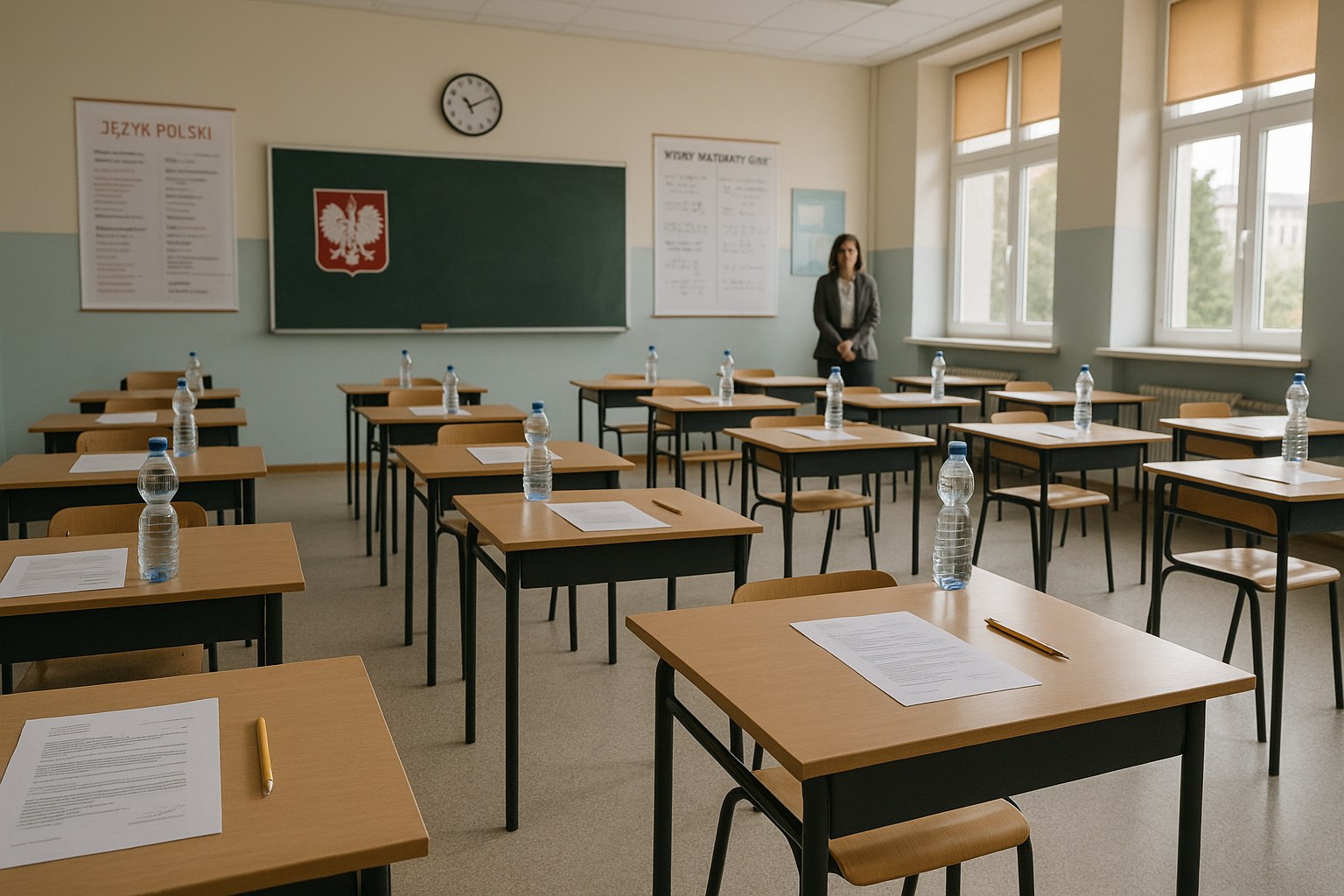
If your child is approaching those teenage years or you’re moving to Poland with a teen, you’ll need to navigate secondary school enrollment. In Poland, secondary education encompasses high schools (liceum), technical schools (technikum), and vocational schools, generally for ages 15–19. The process here is a bit different from primary because there’s no automatic “district” assignment — it’s more about choice and merit 🎯.
Finishing Primary – The 8th Grade Exam 📝: Polish students in the final year of primary school (8th grade, around age 15) take a standardized exam in late spring. It covers Polish language, math, and a foreign language (usually English) as core subjects, and sometimes an additional subject. This Egzamin Ósmoklasisty is crucial. The scores, along with the student’s school grades from 7th and 8th grade, are used to calculate points for high school admission 📊. Each exam is scored out of 100 points and combined with school grades and extracurricular achievements to create a final score for admissions.
High School (Liceum/Technikum) Application 📄: In May, 8th graders (with guidance counselors’ help) submit a ranked list of preferred schools and profiles. Then, after exam results come in (early July), the system matches students to schools based on total points. Mid-July, results are published, and students confirm placement by submitting original school certificates and documents 📁.
Foreign Students 🌍: If your child didn’t take the Polish 8th grade exam, the admission process is handled on a case-by-case basis. Translated foreign school records, entrance tests, or interviews might be required. Local authorities can assign spots, and schools may recommend more open or less academically rigid options like a technikum or vocational school if language skills are limited. Polish is not always mandatory, but it helps — a lot 💬.
Bilingual & International Programs 🏫: Some liceums offer bilingual classes (Polish-English or Polish-Spanish). These may require additional language tests, and competition can be high. For fluent English speakers, Polish-English tracks are a solid option if entry requirements are met 🎓.
The Matura Exam 🎯: Taken at the end of high school (12th grade in liceum, 13th in technikum), the Matura includes Polish, math, and a foreign language (usually English) at the basic level. Students also choose one extended subject. Foreign students may be granted accommodations like dictionaries or alternate formats. Some consider international school paths (e.g. IB Diploma) instead of Matura if aiming for universities abroad 🌐.
Vocational School Option 🔧: Vocational schools (branżowa szkoła I stopnia) offer apprenticeships and trade-focused education. Language needs are lower for hands-on training, though basic Polish is needed. Students can later transfer to a 2-year continuation school to qualify for Matura and university if desired 🛠️.
Specialized Schools & Entrance Exams 🧪🎨🏅: Some elite liceums and art/music/sports high schools have their own entry exams or portfolio requirements. These must be researched in advance, especially for athletic or artistic teens. Entrance exams often take place in May, so early planning is key 📆.
Language Barriers & Support 📚: Secondary schools can be strict on Polish proficiency. Still, education is compulsory until 18, so placement will be offered. Some cities have integration-friendly schools or preparatory classes for foreign teens. Language courses (even short-term) before arrival can make a massive difference 🗣️.
Summary ✅: Polish secondary enrollment is a mix of merit, timing, and paperwork. For foreigners, it adds complexity due to language and transcript recognition. Contact the local Kuratorium Oświaty or city education office early. Many teens adapt well and succeed in Polish schools — especially with preparation, community support, and the right school fit 🏆.
The infamous exam hall scene – here, students sit for the 8th grade exam that determines their future high school path. For Polish teens, it’s a rite of passage. For expats, it may mean extra prep or a different track altogether. Either way, it’s a gateway to higher education 🛤️.
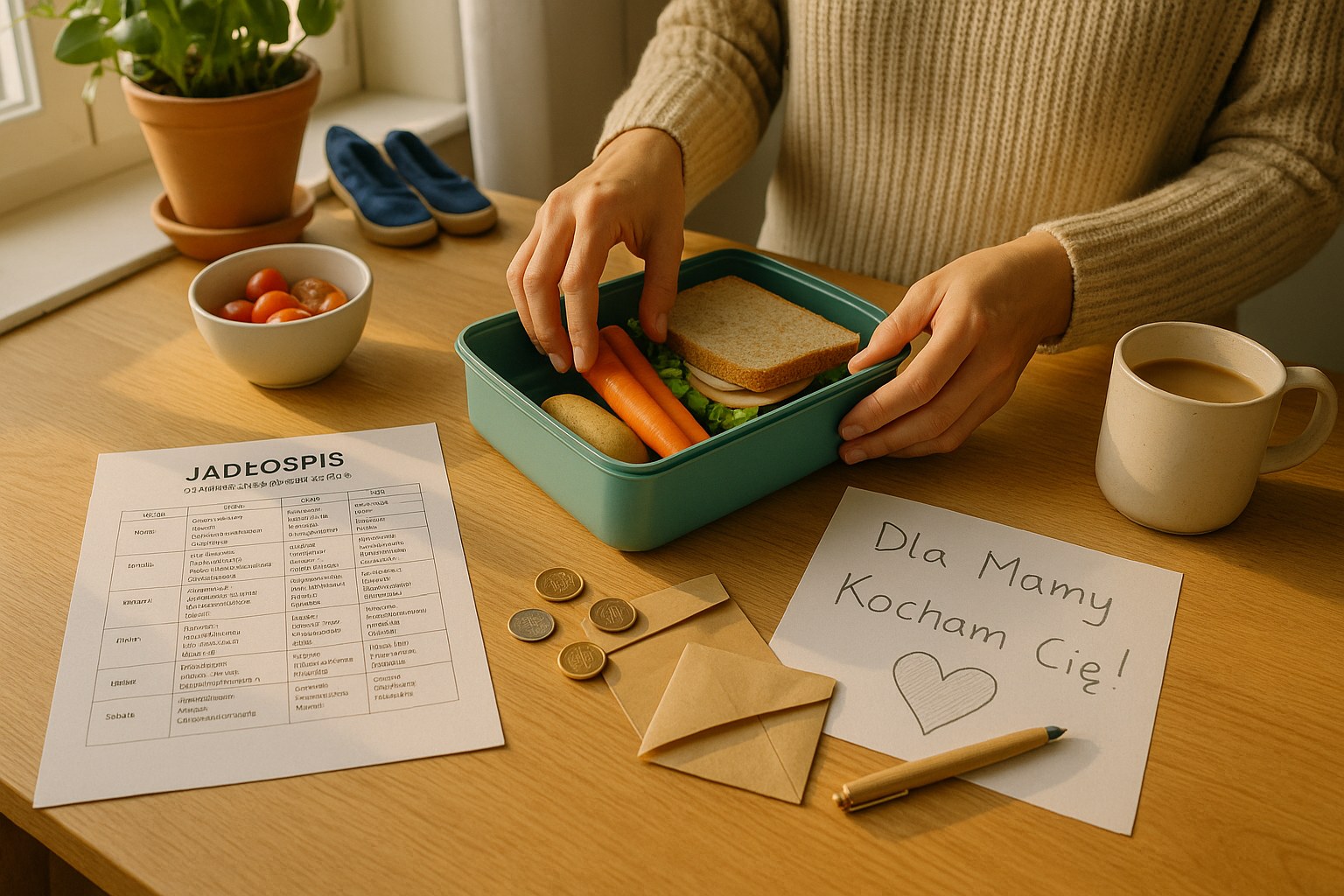
We’ve touched on costs broadly, but let’s dig into some of the day-to-day things that often surprise foreign parents: school lunches, the question of uniforms, and those mysterious class funds and fees that pop up over the year. These aren’t deal-breakers in any sense, but knowing what to expect helps you budget (and avoids that last-minute scramble when your child announces they need 20 zł tomorrow for something).
🍛 School Lunches: As mentioned earlier, many primary schools have an on-site cafeteria (stołówka) or catering service. Unlike some countries, Polish schools do not provide a free hot meal to all students. If you want your child to have a hot lunch at school, you’ll typically pay for it. At the start of the month, you’ll get a menu and cost breakdown. You often pay monthly in advance (or sometimes weekly) for each meal. The cost is generally reasonable – roughly 5 to 10 zł per meal, or ~150–200 zł monthly. Meals include soup 🥣, a main course 🍲, and possibly compote (a fruit drink 🧃). Vegetarian options are more common now, but vegan or allergy-specific menus can be tricky. Packed lunches may be necessary. Low-income families can apply for lunch assistance through MOPS – ask the school for help if this applies.
🥪 Snacks & Second Breakfast: Polish kids often bring a “second breakfast” (drugie śniadanie) – a sandwich, fruit, or snack for the mid-morning break. While some schools have tuck shops or vending machines, many don’t. A packed snack plus a water bottle 💧 is a good idea.
🧢 Uniforms (or lack thereof): Good news: Polish public schools don’t require uniforms! Casual, modest clothes are fine 👕. Only some private or religious schools have dress codes. However, indoor shoes 👟 are usually required – kids change them at the entrance. These stay in school to keep floors clean during muddy or snowy weather.
👟 Gym Outfit: For PE, students need a plain white t-shirt and dark shorts for indoor sessions, plus sports shoes. Some schools offer optional branded shirts, but these aren’t mandatory. Pack warm tracksuits for outdoor PE in chilly months.
💸 Class Fund / Komitet Rodzicielski: Early in the year, parents may be asked to contribute to a class fund managed by a parent committee. It covers extras like art supplies, decorations, or teacher gifts 🎁. Contributions (e.g. 50–100 zł) are voluntary but common. There’s light social pressure, but no shame for those who can’t contribute. Some schools also have a general fund for the whole school.
🧾 Other Collections and Payments: Expect small requests during the year:
It may feel like a lot of nickel-and-diming 💰, but overall these are manageable. Aside from start-of-year supplies (~300 zł) and lunches, expect occasional 10–50 zł requests. Some schools still use the “envelope system” – label the envelope with your child’s name and class, and send in the cash. Yes, it’s still a thing 📩.
Compared to many countries, schooling in Poland is gentle on your wallet. No uniforms, free textbooks, and public schools mean no tuition. Hidden costs usually enhance the experience – better supplies, fun trips, and warm meals. If needed, quietly speak with teachers or reps – subsidies and discreet assistance exist. Every child deserves full participation, no matter the family budget.
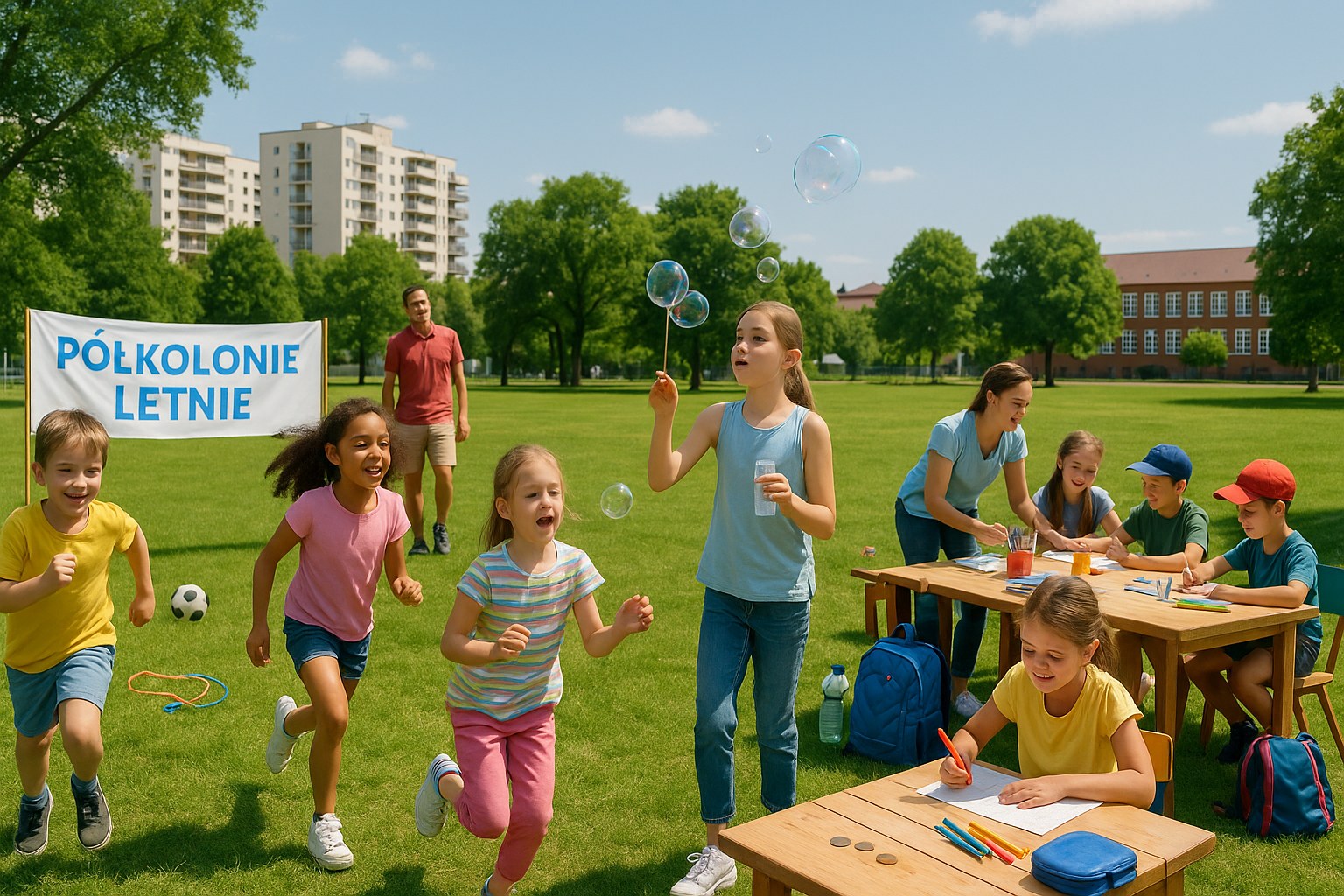
School’s out – now what? Working parents in Poland face the same dilemma as parents everywhere: how to juggle childcare during school holidays. With nearly two months of summer break and assorted other days off, it’s important to have a game plan. Here we’ll outline the main holiday periods (some of which we covered in the calendar section) and common solutions for child care or activities during those times.
☀️ Summer Vacation (Wakacje Letnie): This is the big one – roughly July 1 to Aug 31 off from school. If you’re an expat working in Poland, note that standard annual leave from work is about 26 days (for full-time employees). Clearly, that won’t cover the whole summer! Polish families often patch together various solutions:
<strong❄️>Winter Break (Ferie Zimowe): Two weeks in Jan/Feb, staggered by region. Cities organize themed winter camps and activities, while some parents use vacation time or coordinate care with other families. Overnight ski or snowboard camps are also popular. Trading playdate duty or hiring short-term help is common during this time.
🎄 Christmas Break: Lasts from around Dec 23 to early January. Since workplaces slow down, many families travel or take time off. If working, you may need to arrange short-term childcare. Camps are rare, so the break is typically family-focused or screen-time heavy for kids while parents juggle work-from-home.
🗓️ One-day Holidays and Long Weekends: Expect scattered closures for national holidays and “bridge days.” Some private centers offer one-day workshops. Otherwise, you’ll need to rely on personal leave, playdates, or short-term babysitters.
👶 Kindergartens during breaks: Public preschools usually stay open year-round except for short closures in summer or major holidays. Cities ensure coverage by rotating which facilities stay open. You may need to pre-register for alternate care if your usual preschool is closed.
⏰ After School Hours Daily: Primary schools offer świetlica (after-school care) until 5–6pm. It’s free and helpful for working parents. On odd days like exam periods or pre-holiday breaks, schools often keep świetlica open for younger kids – just sign up in advance if you need it.
👩🍼 Babysitters and Cultural Solutions: Poland’s childcare market is affordable. You can hire help through services like niania.pl or ask local students. Some families also send kids to stay with relatives, especially in summer. Occasionally, Polish friends may invite your child along to their holiday house or camp – a gesture of inclusion you shouldn’t rely on but may gratefully accept if it happens.
🎯 Ultimately, managing school closures in Poland is a jigsaw puzzle – but a solvable one. Use a mix of vacation days, camps, and community support. Planning ahead makes a world of difference. Sign-ups for summer activities often start as early as May. Poland’s family-friendly culture and variety of options make even long breaks manageable and meaningful.
🏕️ School’s closed, but the fun (and learning) doesn’t stop. When summer or winter break rolls around, many parents turn to day camps and activities to keep kids busy. Here, a group of youngsters at a Warsaw summer camp chase bubbles in the park instead of chasing the school bell. With a patchwork of camps, trips to grandma’s, and some parental flexibility, those long school holidays become an opportunity for adventure rather than a logistical nightmare.

No school experience is perfect. As an involved parent (and particularly as a foreigner navigating a new system), you might encounter issues – it could be anything from your child feeling bullied or left out, to bureaucratic frustrations, or a teacher’s approach not sitting right with you. It’s important to know how to address problems effectively, and what channels exist if you need to escalate a situation. Poland’s schools have hierarchies and safeguards to ensure every child’s rights are protected, but you sometimes have to prod the system to get action.
🎓 Classroom or Teacher Issues: If the issue is at the class level – say, you think the teacher is unfairly grading your child or not accommodating their language needs, or there’s a minor conflict – the first step is always to talk to the teacher. Request a meeting (most are available on a certain day for consultations, or you can catch them after class hours). Approach it as a collaboration: e.g., “I’ve noticed Maja is struggling with X, and I’m concerned. How can we work together to help her?” Many times, what seems like an issue might be a misunderstanding. Polish teachers generally appreciate respectful, proactive parents. Use email if available; lots of schools use e-dziennik (electronic gradebook) which has a messaging feature, but writing in Polish helps – you might need to use a translator tool if your Polish isn’t up to it, or politely ask if the teacher is comfortable in English (some are). Keep the communication polite and specific.
🧑🏫 Escalating to the Principal: If talking to the teacher doesn’t resolve it or the issue is with the teacher themselves (worst-case, say a teacher making insensitive remarks about foreigners), then you escalate to the school Principal (Dyrektor). The principal has authority over staff and student affairs. Come with your concern clearly outlined, any evidence or examples, and if possible, a suggested solution. Principals are obligated to ensure student safety and uphold laws against discrimination. They can organize interventions, observe classes, or involve other families if needed.
🚨 Bullying and Discrimination: Unfortunately, foreign children can face bullying – whether for their accent, skin color, or background. Most schools have an anti-bullying policy. If your child experiences harassment, report it early. Inform the homeroom teacher first, then escalate if necessary. Schools can involve psychologists, organize talks with other parents, and provide support. For language-based exclusion or grading bias, use terms like “mobbing” (bullying) or “dyskryminacja” (discrimination). Reference your child’s right to education and support under Polish law. You can even cite the Constitution if needed – though most schools will respond before it gets to that.
🏢 When the School Doesn’t Help: If you’ve gone through teacher and principal and still no resolution:
📚 Common Problems & Fixes:
👨👩👧 Parent Councils: Join the Rada Rodziców to have a voice. These councils can pressure school authorities to improve policies or infrastructure. Foreign parents are welcome and encouraged to participate.
🛡️ Summary: The chain of escalation is: Teacher → Principal → Kuratorium → Ombudsman, with parent councils and NGOs as allies. Document everything. Be calm, assertive, and know your rights. Polish schools are legally obligated to protect students, and most will act if nudged correctly. You’re not just a foreign parent – you’re an informed one who can advocate with confidence.
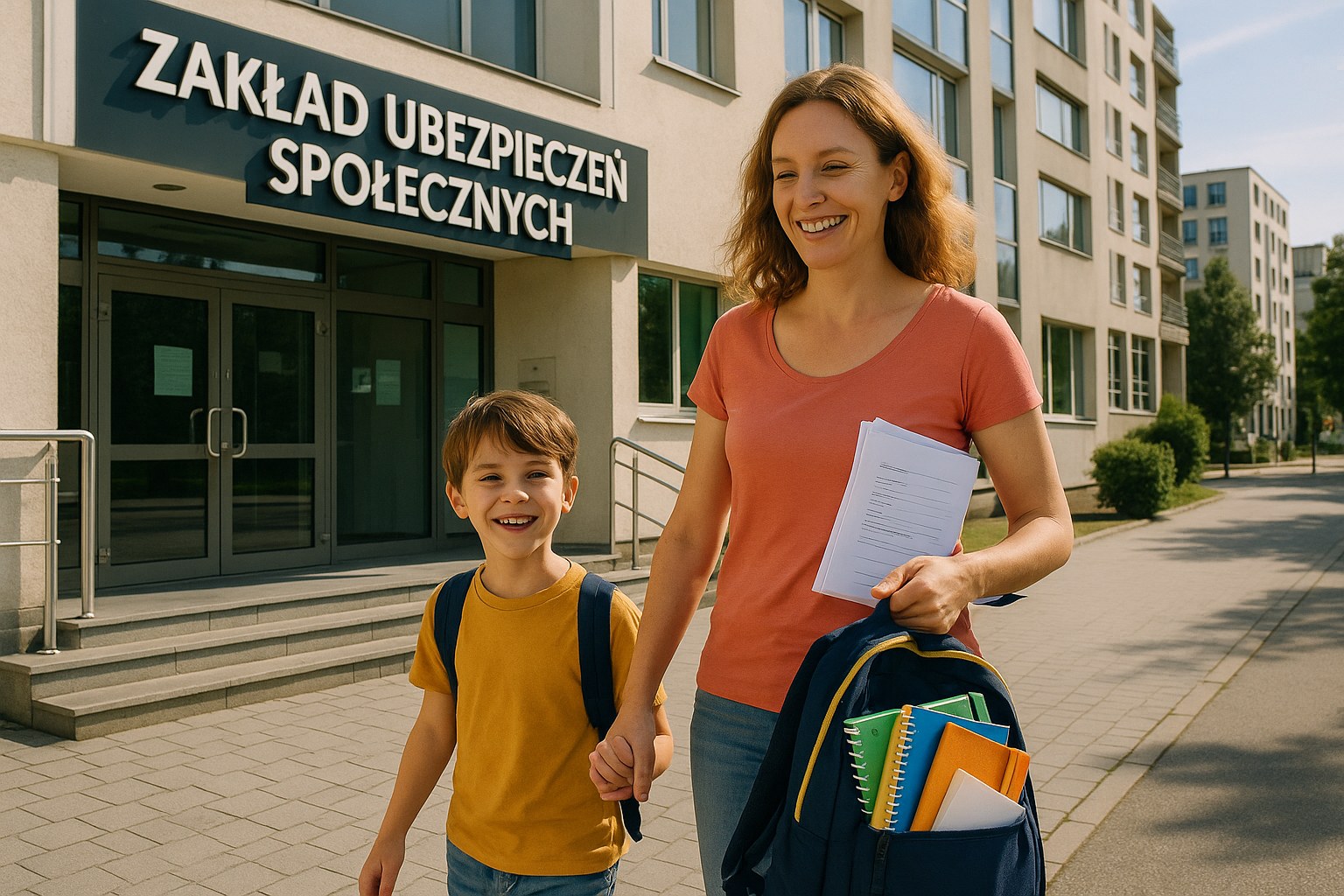
Raising kids is expensive 💸 – the Polish government knows this, and there are programs to ease the burden, especially for school-related costs. As a foreign or expat family, you might be eligible for some of these benefits, so it’s good to know what’s out there and how to claim it. Let’s go through the big ones: the “Dobry Start” 300+ program, and other financial aids like the famous 500+ child benefit, scholarships, and local support for students.
🎒 Dobry Start (300+): This is a one-time annual grant of 300 złoty, given to every student in Poland (regardless of income) who is enrolled in school, to help cover the costs of the new school year. It’s often called “wyprawka 300+” meaning the 300 zł school kit. It’s intended for kids from grade 0 (zerówka) through high school (up to age 20, or 24 if disabled). Preschool kids (ages 3–5) do not get it, but the year they enter zerówka, they qualify.
The timeline: you apply once per year, usually between July and November 📆. It’s all done online now – typically via the ZUS (Social Insurance Institution) portal or your bank’s online banking 💻 (many banks integrate government benefits applications). Since 2022, ZUS handles it, not the local authorities.
As a foreigner, you’re eligible if you are legally residing in Poland and your child attends school here 🏫, generally on the same basis as Polish citizens. There used to be conditions for non-EU citizens, but rules have loosened. EU citizens or those with temporary residence cards (linked to family or work) or permanent stay permits should get it. If you’re on a visa or short term, you might not – but just apply and ZUS will verify 🧾.
You’ll get 300 zł per child, usually by September 💰. It’s not monitored how you spend it – but obviously, it’s meant for school supplies, textbooks, new shoes, etc. Don’t forget to apply each year – it doesn’t recur automatically.
👶 500+ (Rodzina 500 Plus): Not school-specific, but it’s a big one: 500 zł per month per child (increased to 800 zł from 2024). Every child under 18 qualifies, regardless of income. Foreigners must usually have a temporary residence permit with access to the labor market, or long-term or permanent status. Ukrainian refugees and others with temporary protection also qualify. Like 300+, it’s managed by ZUS and paid monthly into your bank account.
🌍 Important: If you’re getting child benefits from another EU country, Poland might not pay you 500+ due to EU coordination rules. Only one country pays – usually where you live and work. Avoid double payments by clarifying your status early.
📚 School Scholarships (Stypendium szkolne): Income-based assistance from your local municipality for school needs. You apply through your gmina (often at the social welfare office) in September. The stipend can be 248 zł/month or so, often as reimbursement. Not all expats qualify, but long-term residents on tight budgets should check it out. There’s also a one-time “school allowance” (zasiłek szkolny) for hardship situations like job loss.
🥗 Free School Meals & Supplies: If your income is low, social assistance can help with school lunches, supplies, and equipment – especially for students with disabilities (through the PFRON fund). The school’s pedagogue or city welfare office can guide you on what’s available. Some programs are EU-funded. Watch for back-to-school charity drives in stores – schools distribute those to students in need.
💼 Tax Deductions: Small but nice – Poland’s annual PIT tax return offers a child allowance (ulga na dzieci). For most families on standard employment contracts, that’s 1112 zł/year for one child, more for multiple kids. It may not apply under flat tax. Check with your accountant.
🏫 Local and School Initiatives: Some schools have funds to cover backpacks or class trips for kids in need. Let the school know if you’re struggling – they often help quietly. You might benefit from the komitet rodzicielski or NGO donations (especially in late August during supply drives).
🎓 Don’t Forget Higher Education: If your child studies at a Polish public university in Polish, it’s free. Private schools and English-language programs cost more, but there are scholarships – like for students with Polish heritage (Polonia). University costs are low overall 💡.
✅ In Summary: Poland offers generous family benefits compared to many countries, and foreigners with the right status aren’t excluded. Apply for what you qualify for. Nothing is automatic (except 500+ after approval). Track dates: 300+ opens every summer, and schools usually remind families about other aid in September. If you’re legally in Poland with kids, these benefits help ensure your child gets everything they need – without breaking your wallet 💸.
Cha-ching! 💼💥 Come back-to-school season, Poland invests in your kid’s success. From 300+ supplies to monthly 800+ child payments, free meals, or extra help from the school, savvy parents take advantage of what’s on offer to give their child the best shot at thriving 📈.
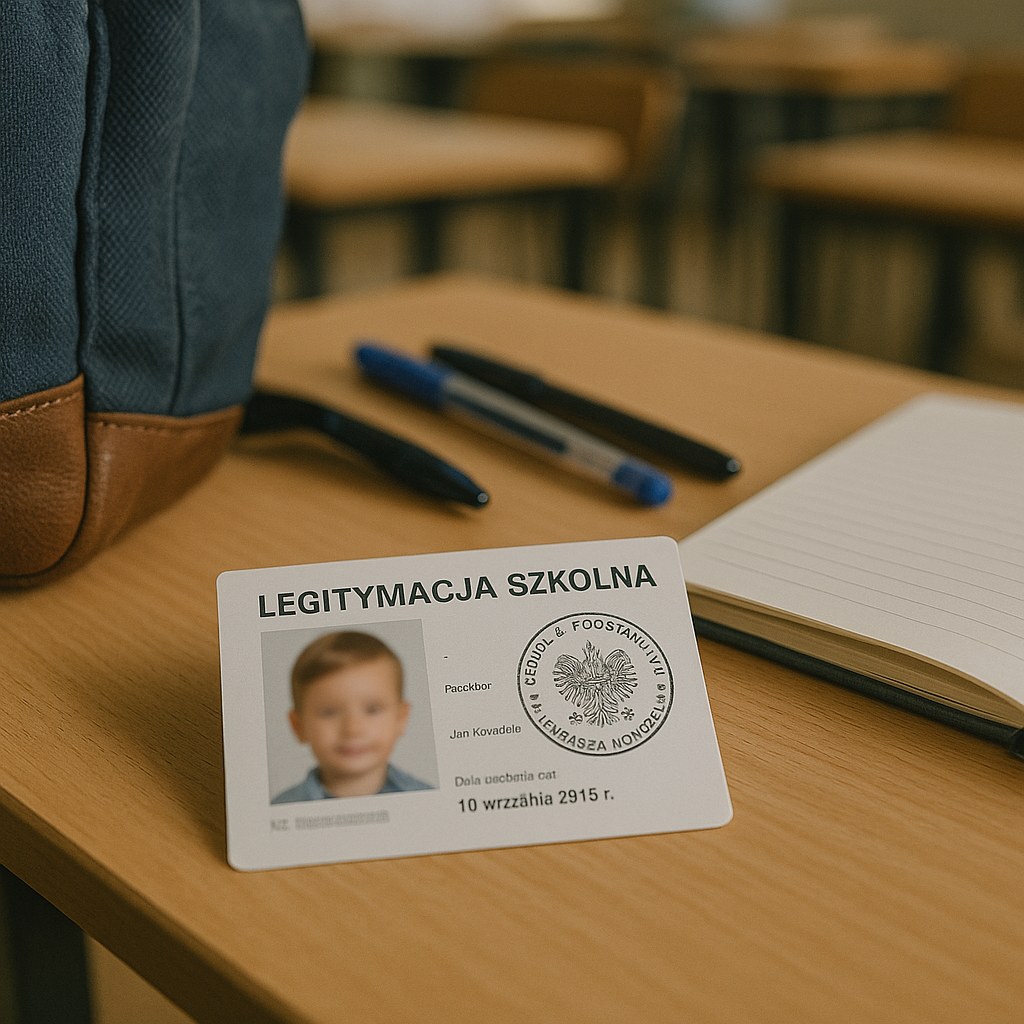
One of the first “official” things your child will get after enrolling is a school ID card (legitymacja szkolna). Don’t let the small size fool you – this little piece of laminated paper opens up a world of discounts and conveniences for your kid 🎟️. Let’s break down why the school ID matters and what you should do with it (aside from hoping your child doesn’t lose it in their messy backpack 🎒).
What is the School ID? It’s a small card (about the size of a credit card, though typically made of laminated paper) with the student’s photo, full name, PESEL number, date of birth, and school details. It will have the school stamp and the signature of the principal. On the back, there are fields for validation stamps for each school year 🗓️. Each year, upon confirming the child is still a student, the school secretary or homeroom teacher will put a date stamp to extend its validity (usually till end of September of the next year). This ensures the ID is current.
You typically need to provide a photograph of your child (passport size – 3cm x 4cm) soon after enrollment to get the ID made. Some schools do a photo day 📸, or you just bring one. If your child is starting zerówka or 1st grade, expect a note about this. Once the school prepares the ID, they’ll give it to your child (or to you). For older students transferring in, ask the office to issue one as soon as possible.
Half-Price Travel 🚆: The biggest perk: school IDs entitle school children to about 50% discount on public transport fares across Poland. This includes city buses, trams, metro, as well as PKP intercity trains and many private buses. For trains, the statutory discount is 37% (weird number, but that’s what the law sets for ulgowy fare on PKP) – however, PKP often adds their own promotion making it effectively ~51% off the normal price.
For local transit: e.g. in Warsaw, kids with school ID ride for free until end of primary (because Warsaw city policy gives free rides to under-~15 with ID) and then half-price in secondary. In Kraków and other cities, typically 50% off for all students 7–19 with ID 🚌. So, when your child starts school, you no longer buy full-price tickets when traveling. Even going to the Tatras for a weekend, flash the school ID at the train conductor and pay the child rate. Important: you must carry the ID during travel; if a ticket inspector asks for proof of discount and your child doesn’t have it, you can be fined as if no ticket. So make it a habit that the ID travels with you on trips 🎫.
Other Discounts 🎟️: Many museums, cinemas, theaters, and tourist attractions offer reduced ulgowy tickets for students. This usually includes not just Polish kids but any student under 26 with a valid student ID (university students have their own ID, but school kids use the school ID). For example, a movie theater might have student tickets that are a few złote cheaper. Museums often have hefty discounts – e.g., Wawel Castle ticket for a child might be half the adult price with ID 🏰.
Even some fast food or retail stores offer student deals. Essentially, whenever you see a price list with “normalny” (regular) and “ulgowy” (reduced) – your school-age child qualifies for the ulgowy by showing the ID. There are some exceptions: very young kids often get free entry anyway (like under 7 sometimes free in museums), but for ages 7+, the ID secures the lower price 🎟️.
Proof of Age/Status 🆔: The school ID is an accepted ID document for your child, which is handy because kids under 18 often don’t have any other photo ID (unless you got them a passport or a residency card). For example, if your 14-year-old needs to pick up a package at the post office (less common, but say a letter in their name), the school ID is an official doc to prove identity and age. It’s also useful for things like signing up for a library card at the public library – usually they’ll take the school ID as identification 📚.
Access to Healthcare 🏥: Children under 18 in Poland are covered by state healthcare, and usually, you’d show their PESEL or insurance number for doctor visits. Occasionally, a clinic might ask for an ID for the child especially if they look older and you’re claiming they’re under 18 to avoid fees. A school ID can serve to prove they’re a minor/student. Mostly not needed, but nice to have if asked for identification at e.g. a hospital desk.
Student Events & Discounts 🎉: Towns often host special events for students – e.g., free entry to swimming pools on Children’s Day for students, or discounted tickets to concerts for youth. The ID is your passport to these benefits. Also, many interschool competitions or exams require the student to present their ID for verification (for instance, when my daughter went to a regional math contest, they checked her school ID to ensure she’s the right person from X school).
Safety and Curfew Considerations 🚓: Poland doesn’t have a formal youth curfew, but there are rules like no alcohol/tobacco sales to under 18. In rare scenarios, if a young teen is out alone late, police might stop and ask for ID to verify age or identity. A school ID can be shown – it’s not the same as a government ID, but likely the police would accept it as proof of being a minor and then either escort them home or notify parents depending on the situation (that’s an extreme case, but just saying, it serves as some form of ID).
Replacing and Updating 🔄: If the school ID is lost, stolen, or damaged, you can get a duplicate from the school, often for a small fee (like 9 zł). Don’t wait on that, because any period without ID means paying full fare on transit, etc. Also note, if any info changes (say your child’s name changes due to some official reason or they move to a different school), you’ll need a new ID from the new school.
On transferring schools, you hand in the old ID to the previous school (they usually stamp it “invalid” so it can’t be misused). The new school will issue a new one. If your child finishes primary and goes to secondary, the primary school ID should be returned and they’ll get a new one from the high school 🎓.
One more thing: While your child has a school ID, you as a parent can also benefit indirectly – for example, some places have family tickets or allow an adult accompanying a group of students to also get a discount. If you ever travel with a bunch of school kids (even your child and a friend), ask if there’s a group or guardian discount. A little known fact: if you have at least two schoolkids with IDs traveling by train, you can get a “grupowy” (group) discount for everyone including the adult 👨👧👦.
In summary: Once that school ID is in your hands, you’ll want to maximize its use. Show your child how to carry it safely. Make a digital copy or note of the ID number in case it gets lost. The ID validity technically extends a bit beyond the academic year – usually until end of September of the graduating year – but once your child is no longer a student, the ID is not valid for discounts. While it’s valid, definitely enjoy the perks 💸.
Don’t leave home without it! This little school ID card is a golden ticket for your youngster – think half-price bus rides, cheaper movie tickets, and proof positive that they’re a student 🎫. Flashing the legitymacja szkolna turns “Can I afford a train trip?” into “Full steam ahead, I’ve got my discount!” 🚄

Earlier we talked about school zoning (“rejonizacja”) – now let’s get practical. How do you actually find which school is your local designated school? And if you’re not keen on that one, how do you locate other nearby schools that might be options? Thankfully, you don’t need to wander the streets looking for clusters of kids. There are tools and resources to make this easy. 🗺️
City Education Websites: Most cities in Poland have a section on the official city website for education (often under “Edukacja” or sometimes a dedicated portal). There you can usually find a “school search” or list of district boundaries. For example:
If online tools fail or are too confusing, you can visit or call your gmina office (urząd gminy) or local school board and simply ask, “What school is for this address?” They can tell you quickly.
Enrollment Portals: When it comes time for official enrollment (especially for 1st grade or preschool), many cities have an online portal. You’ll put your address in during application, and it might auto-fill or suggest the zoned school as a default pick. For instance, the Oświata (education) electronic systems used in many places have that functionality. But remember, just because you find the zoned school doesn’t mean you can’t apply elsewhere – you can, you just aren’t guaranteed a spot there. 🧾
Maps and PDFs: If you prefer old-school methods, lots of city BIPs publish PDFs each year listing all the street names under each school’s district. You could find the one for your area and scan it. Keep in mind that boundaries occasionally change if a new school opens or demographics shift, but generally not drastically year to year.
Secondary School Catchments: As mentioned, high schools (licea, technika) don’t have catchment zones – they admit based on points. So for those, your tool is the list of schools and their offerings. Cities often provide a list of all high schools, often with info like what profiles (e.g., math-physics, humanities) they have. Some even have a “choose by interest” tool. For example, the Warsaw education site might let you filter high schools by district or profile. But since it’s points-based, you can technically consider any school in the city. 🚇 Consider commute though – a cross-town trip at 7am might not be fun daily.
Assigned School Not to Your Liking? If you find your zoned school and hear it’s not great, you might want to look at alternatives. Use the city’s list of all primary schools to see what else is within reasonable distance. Then you can try for those. Remember, you’ll need to actively apply to a non-zoned school; they won’t automatically consider you. Some cities allow listing multiple choices. Do your homework: check school websites, visit if possible, or ask neighbors/expat forums for reputations. For instance, maybe your zoned school is average but there’s another one 1 km away known for a great English program – you might aim for that one. 📝
Tools for School Quality: How to benchmark schools? Poland doesn’t have official school rankings for primary because all have to follow the curriculum. But you can check the “egzamin ósmoklasisty” results (8th grade exam averages) which some school websites or BIPs publish. Higher average might mean a more academic school (or just a selective one). Also, talk to parents or look for Facebook groups like “Foreigners in [City]” – questions about good schools often pop up. There’s also a site waszaedukacja.pl which ranks high schools by exam results, etc., primarily for high schools though. 🧠
Kindergarten Assignment: For younger ones: to find your local public przedszkole (kindergarten), similar gmina tools exist. Many list which preschools serve which neighborhoods. Still, you’d typically apply to the closest ones first for higher chance. Use city recruitment sites for preschools, or ask the nearest primary school – they often know which preschool is nearby affiliated. 🎒
Key Links Examples:
Remember to factor in practical things like distance and commute when eyeing schools. A fancy school across town with no direct bus may be less ideal than a decent one around the corner. 🏃 Primary kids often attend nearest because they’re young; by high school, kids are more independent and can travel further on their own. Also, consider after-school activities: if your child will attend music school or sports in evenings, sometimes picking a school near those can help logistically.
In summary, use the digital tools provided by city education departments to pinpoint your assigned school and get to know your options. It’s a bit of an address-based treasure hunt 🧭, but once you find “the one” (or the short list of ones) you can proceed confidently with enrollment procedures, knowing you’re headed to the right place – literally and figuratively.
When in doubt, map it out! 🗺️ A mom zooms in on an interactive school district map of Warsaw, pinpointing exactly which primary school her street belongs to. No more guessing or wandering – a few clicks and she’s got the address, name, and even the phone number of her child’s soon-to-be school. From Kraków to Gdańsk, similar tools take the mystery out of “Where do I enroll?” – just plug in your address and follow the digital breadcrumbs to your district school.
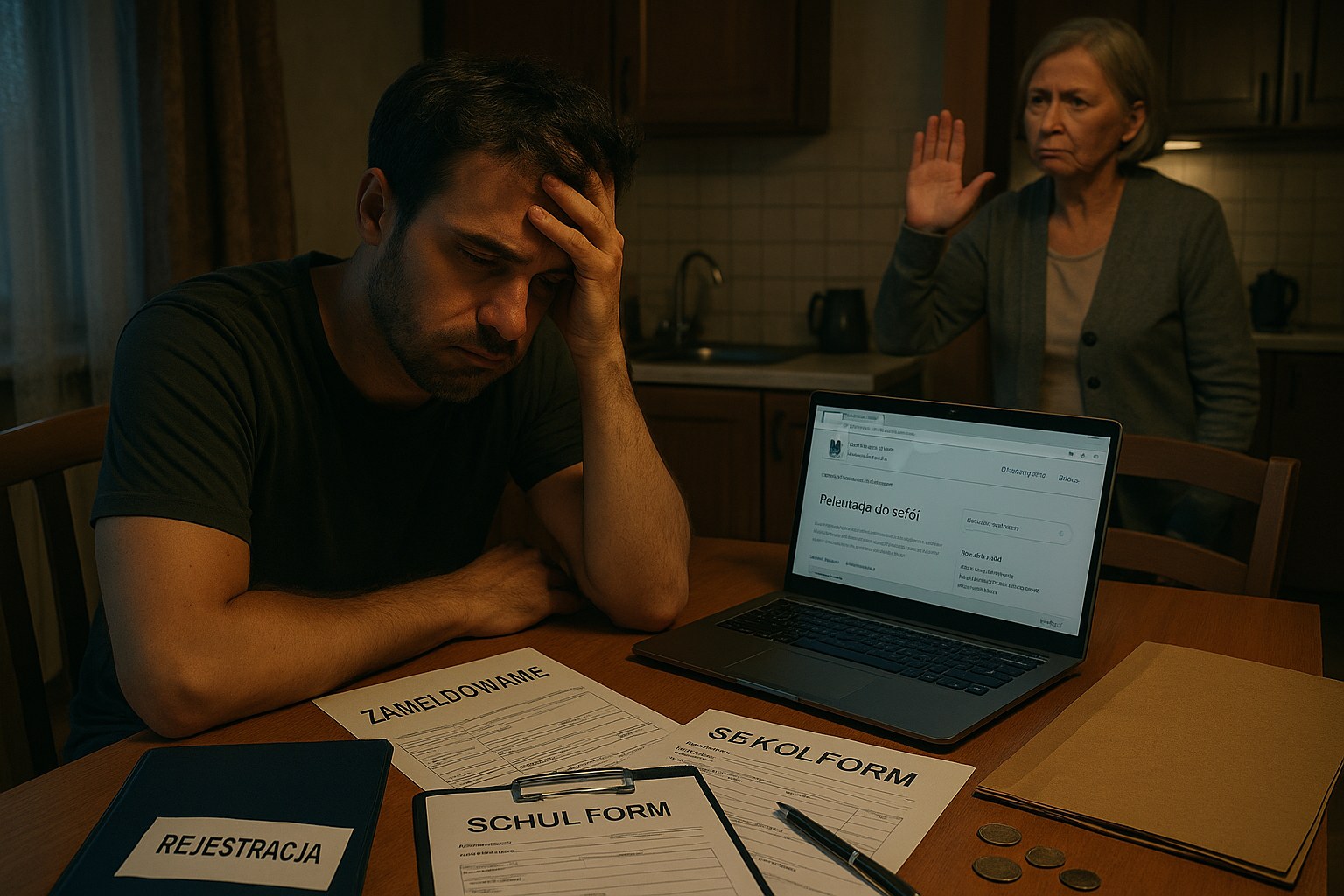
No journey is without a few bumps in the road. Enrolling your child in a Polish school is generally straightforward, but occasionally Murphy’s Law strikes. Let’s troubleshoot some common issues foreigners might face – and how to overcome them so they don’t derail your plans.
As discussed, official address registration (meldunek) isn’t a strict requirement for enrollment, but having some proof of residence is important for getting into your district school. Some landlords refuse to cooperate, often due to fear of taxes or misunderstanding. If you’re stuck without a zameldowanie certificate, try this:
Bottom line – no meldunek is a hassle, not a blocker. Many schools found creative workarounds post-2022 for displaced families, and your case likely isn’t the first.
If systems go down or names get misspelled, remain calm. Schools often accept paper applications if online tools fail. Mistakes can be fixed – keep receipts and follow up if delays occur.
Expect differences – formality in titles, church outings, blunt feedback. You can opt out of religious activities. If something feels truly wrong (like discrimination), speak up. But for minor cultural quirks, adapt gently.
Moving countries is hard. Find support in expat parent groups or local communities. Schools often have psychologists to help kids transition. You’re not alone – most parents go through this adjustment curve.
The Bottom Line: Virtually every problem has a workaround. If you stay calm, know your rights, and ask for help when needed, Polish schools will almost always find a way to get your child learning.
Keep calm and carry on enrolling. Sure, the form is ten pages of Polish legalese and your landlord won’t sign that weird meldunek paper. But armed with Google Translate, a dash of determination, and our guide, you’ve got this. When things go wrong – missing documents, language headaches, or a landlord stuck in the 19th century – just remember: every problem has a Polish solution (usually involving a stamp, a form, or a friendly clerk). Breathe, troubleshoot, and before you know it, junior will be off to class with barely a hiccup in his Polish adventure. 🇵🇱🎒
Almost all of these issues — landlord refusals, missing contracts, no bank account — are solvable with the right help. If you’re stuck, our Relocation Services exist to make this easier and prevent costly mistakes.
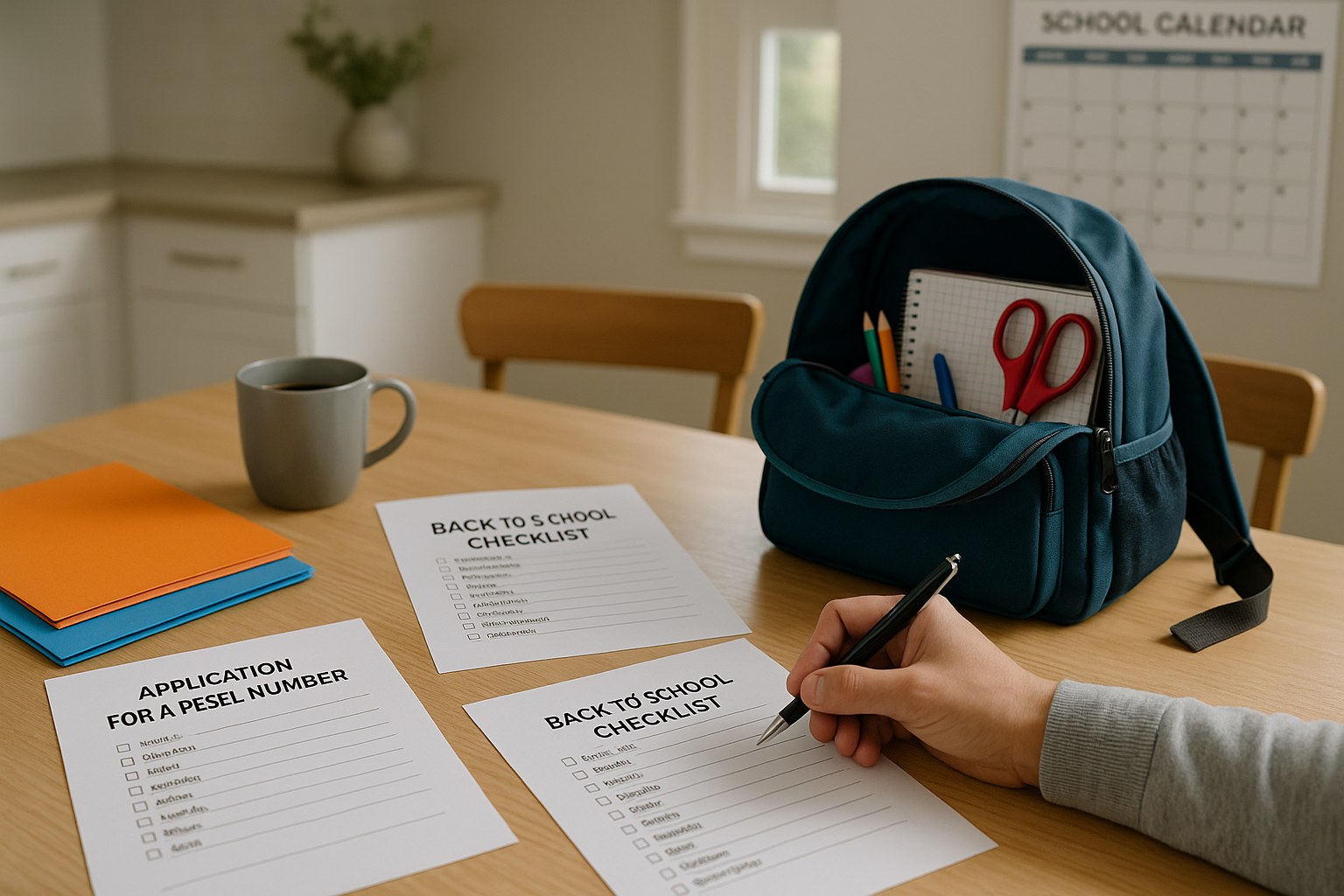
We’ve covered a ton of ground – now let’s boil it down to an actionable checklist. Here’s your step-by-step guide to ensuring you’ve ticked all the boxes (literally and figuratively) for enrolling your child in school in Poland and navigating the initial period:
With this checklist, you’re covering legal, practical, and emotional bases. Keep it handy and tick things off as you go – it’s satisfying and ensures nothing vital slips through. Every item you check is one step closer to a smooth school experience for your child (and you). Congratulations – you’re well on your way to mastering the Polish school system like a pro!
List lovers, rejoice! A no-nonsense checklist keeps even the most frazzled foreign parent on track. From “Get PESEL numbers” to “Buy indoor shoes” to “Breathe (you got this)”, every task is neatly ticked off. With boxes checked and ducks in a row, you’re ready to send your child into the Polish education wilds, confidence high and panic low. Onward to Day One!

Enrolling your child in a Polish school as a foreigner might have felt like planning an expedition up Mount Everest – steep learning curves, unpredictable weather (of bureaucracy), and perhaps some butterflies in the stomach. But take a moment to look back at how far we’ve come in this guide: from deciphering the education system, collecting documents, and wrestling with forms, to understanding the subtleties of lunch payments and holiday camps. It’s a journey, but one you’re now well equipped to conquer.
The ultimate takeaway? You’ve got this. Poland’s school system, with all its nuances of zero grades, zonings, and zlotys, is no match for a determined parent. Yes, you might have a funny anecdote or two soon – perhaps about the time you accidentally asked the teacher if she was a chalk (hey, kreda vs. krety happens). But those moments of confusion will fade, and in their place will be routine and familiarity. One day you’ll find yourself casually chatting with the school secretary in Polish about the weather as you pick up your child’s legitymacja, and you’ll realize: you’re no longer a newbie at this.
Remember, every challenge is temporary. That first scary meeting where you understood only “Dzień dobry”… soon enough, you’ll catch phrases and context. That mound of paperwork will get done (and then it’s mostly done for good – subsequent years are easier). The landlord who won’t cooperate – you’ll find a workaround or eventually move to a more accommodating place. And your child, who might today be nervous or not grasping everything, will in a few months amaze you by singing a song in Polish or explaining how to do long division the Polish way. Kids are resilient and soak up the new environment like sponges, especially when they see their parent confidently leading the way.
Trust the process and trust yourself. You’ve navigated life to a point where you’re raising a family in a foreign country – that’s an achievement of courage and adaptability. If you can do that, you can handle a few parent-teacher meetings and a curriculum night where they discuss reading assignments you’ve never heard of (hello, Polish literature!). And guess what? You’re not alone. There’s a community of expat and mixed-nationality parents out there in Poland who have been through this. Don’t hesitate to reach out, ask questions, share a coffee and a laugh over the quirks of Polish schools versus back home. You’ll find camaraderie and perhaps lifelong friends in the process – our kids bring us together in wonderful ways.
When in doubt, refer back to this guide. It’s meant to be exhaustive so you can pinpoint whatever dilemma you face and find clarity. And keep the communication open: with your child (to gauge how they’re coping and where they need support), with the teachers (they appreciate proactive parents, and it helps them help your child), and with yourself – by that I mean, give yourself grace. It’s okay if not everything is perfect from day one. Forgot to sign the notebook? There’s tomorrow. Mispronounced a teacher’s name? You’ll get it next time. What matters is your child sees you tackling this challenge head-on with optimism and determination – that’s a life lesson in itself.
As your child settles into their Polish school adventure, take pride in what you’ve accomplished here. You’ve not only ensured they get an education, but also opened up a world where they’ll become bilingual (or even trilingual), culturally rich, and adaptable – truly little citizens of the world. And you are right there with them, learning and growing. The panic that may have gripped you initially can now firmly take a back seat, replaced by knowledge and confidence.
So here’s to you, the parent who navigated the maze and emerged victorious. May your mornings be smooth, your pack of documents always complete, and your child’s school years in Poland filled with growth, friendships, and success. When graduation day arrives (sooner than we all think), you’ll look back and know that all the effort was worth it, and maybe even chuckle at how intimidating it once seemed. You did it – without the panic, with all the payoff. Powodzenia (good luck) and a heartfelt welcome to the Polish school community!
If you’re still piecing things together, don’t stress — we’ve helped hundreds of families get settled in Poland. Our Relocation Services are modular, affordable, and built exactly for situations like yours.
Typically, you need your child’s birth certificate or passport, previous school records (translated if not in Polish), proof of address, and passport-sized photos. A PESEL number for your child simplifies the process but is not always mandatory.
Most cities provide online tools or maps where you can enter your home address to identify your zoned primary school. Local education offices and gmina offices can also assist if online resources are confusing.
While meldunek helps with enrollment, schools must admit children regardless of meldunek status. Alternative proofs like a lease or utility bill, or a landlord’s confirmation letter, can suffice. You can also escalate to the local education authority if needed.
Yes. Programs like Dobry Start (300+), Rodzina 500+ (or 800+), and local scholarships are available to foreign residents who meet eligibility, typically linked to residence permits and school attendance.
Schools offer extra Polish language lessons and integration support. You can also arrange private tutoring. Encourage social interaction with peers and communicate with teachers about accommodations or buddy systems.
Private and international schools often teach in English and may offer smaller class sizes and specialized curricula. However, public schools provide full immersion, which may lead to faster Polish language acquisition. The best choice depends on your child’s needs and your family’s plans.
Report incidents promptly to the homeroom teacher or school principal. Schools have anti-bullying policies and must address discrimination. If unresolved, you can escalate to the Kuratorium Oświaty or the Children’s Ombudsman.
Use translation tools for emails and documents. Ask if the school can provide English communications. For meetings, consider bringing a Polish-speaking friend or requesting a teacher who speaks English. Many teachers are accommodating once aware of the language challenge.
Yes. Recruitment for kindergartens and 1st grade usually occurs between February and April. High school applications are typically in May and June. Each city publishes specific enrollment calendars – check local education department websites.